Business Statistics Report: Impact of Social Progress Index on SDGs
VerifiedAdded on 2020/12/09
|27
|5365
|203
Report
AI Summary
This business statistics report provides an executive summary of an analysis conducted on data from 182 countries, focusing on the Social Progress Index and its relation to the UN Sustainable Development Goals (SDGs). The report uses randomly selected variables from 12 categories of the index, including deaths from infectious diseases, availability of affordable houses, primary school enrollments, life expectancy, private property rights, and religious tolerance. Employing statistical techniques such as hypothesis testing, correlation, and regression, the analysis investigates the impact of these variables on sustainable development. The findings reveal varying benchmarks across countries for variables like well-being and personal rights, suggesting a need for generalized benchmarks to facilitate easier and more authentic social progress analysis. The report concludes with recommendations to prioritize access to basic knowledge and standardized progress assessment for achieving the UN's sustainable development goals. The report includes descriptive statistics, confidence intervals, and correlation/regression analysis to support its conclusions.
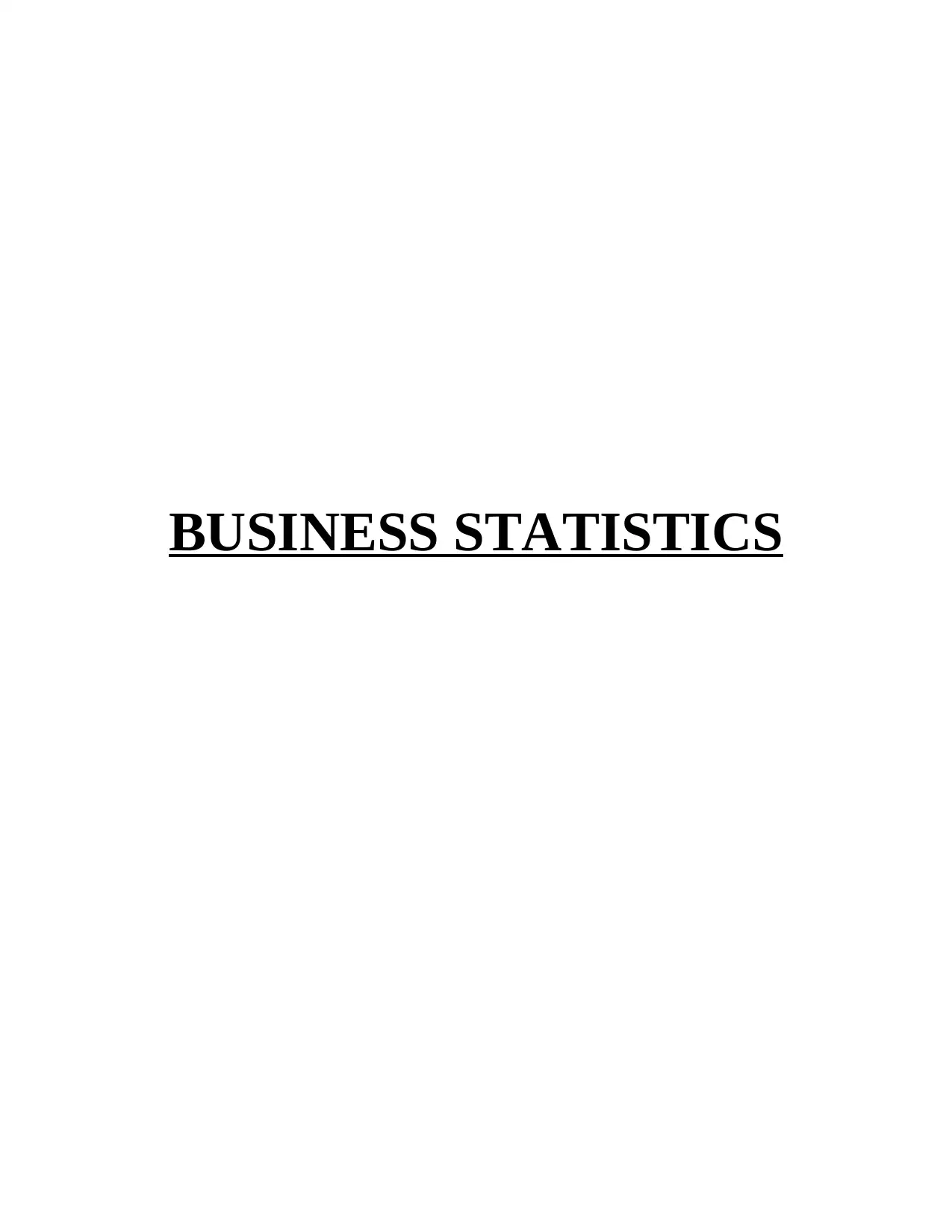
BUSINESS STATISTICS
Paraphrase This Document
Need a fresh take? Get an instant paraphrase of this document with our AI Paraphraser
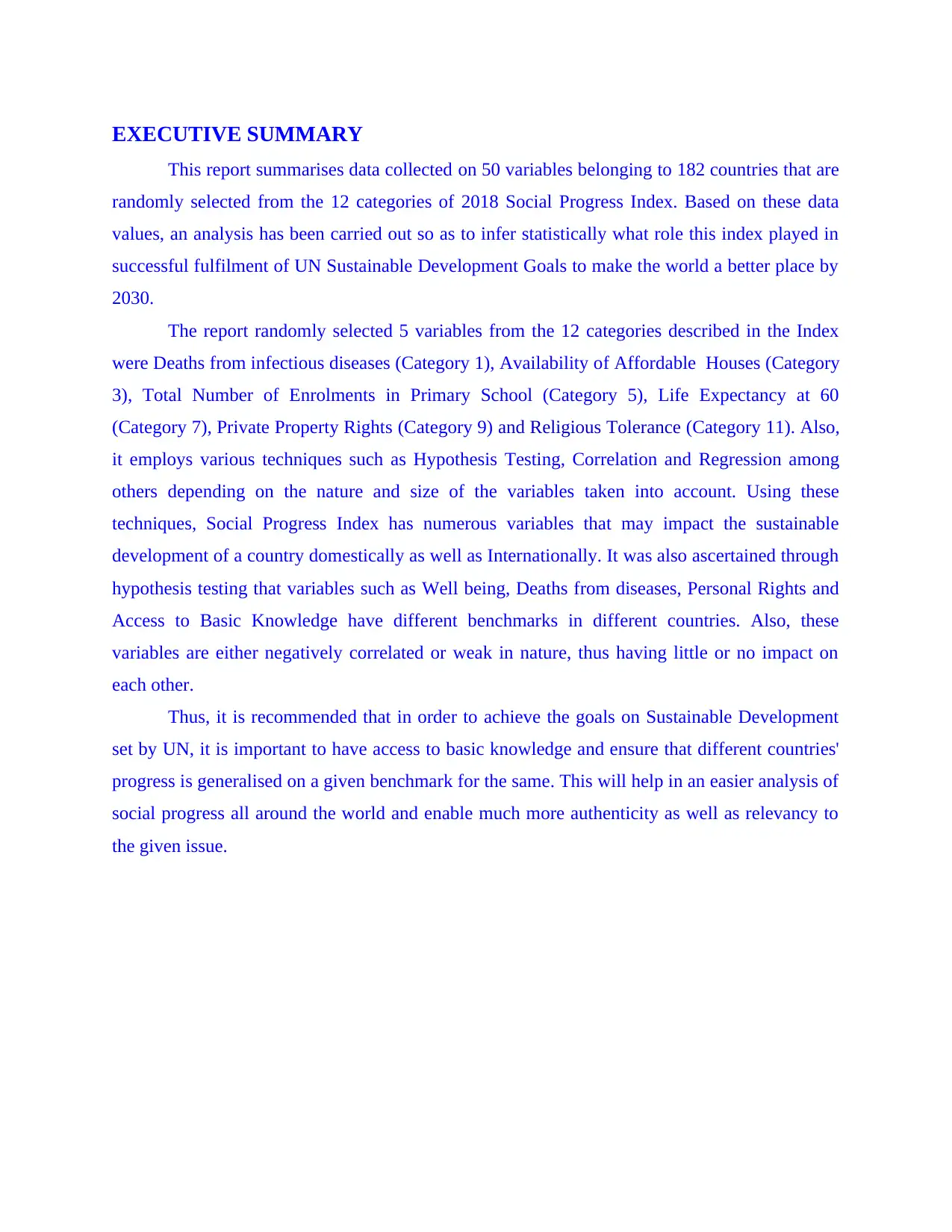
EXECUTIVE SUMMARY
This report summarises data collected on 50 variables belonging to 182 countries that are
randomly selected from the 12 categories of 2018 Social Progress Index. Based on these data
values, an analysis has been carried out so as to infer statistically what role this index played in
successful fulfilment of UN Sustainable Development Goals to make the world a better place by
2030.
The report randomly selected 5 variables from the 12 categories described in the Index
were Deaths from infectious diseases (Category 1), Availability of Affordable Houses (Category
3), Total Number of Enrolments in Primary School (Category 5), Life Expectancy at 60
(Category 7), Private Property Rights (Category 9) and Religious Tolerance (Category 11). Also,
it employs various techniques such as Hypothesis Testing, Correlation and Regression among
others depending on the nature and size of the variables taken into account. Using these
techniques, Social Progress Index has numerous variables that may impact the sustainable
development of a country domestically as well as Internationally. It was also ascertained through
hypothesis testing that variables such as Well being, Deaths from diseases, Personal Rights and
Access to Basic Knowledge have different benchmarks in different countries. Also, these
variables are either negatively correlated or weak in nature, thus having little or no impact on
each other.
Thus, it is recommended that in order to achieve the goals on Sustainable Development
set by UN, it is important to have access to basic knowledge and ensure that different countries'
progress is generalised on a given benchmark for the same. This will help in an easier analysis of
social progress all around the world and enable much more authenticity as well as relevancy to
the given issue.
This report summarises data collected on 50 variables belonging to 182 countries that are
randomly selected from the 12 categories of 2018 Social Progress Index. Based on these data
values, an analysis has been carried out so as to infer statistically what role this index played in
successful fulfilment of UN Sustainable Development Goals to make the world a better place by
2030.
The report randomly selected 5 variables from the 12 categories described in the Index
were Deaths from infectious diseases (Category 1), Availability of Affordable Houses (Category
3), Total Number of Enrolments in Primary School (Category 5), Life Expectancy at 60
(Category 7), Private Property Rights (Category 9) and Religious Tolerance (Category 11). Also,
it employs various techniques such as Hypothesis Testing, Correlation and Regression among
others depending on the nature and size of the variables taken into account. Using these
techniques, Social Progress Index has numerous variables that may impact the sustainable
development of a country domestically as well as Internationally. It was also ascertained through
hypothesis testing that variables such as Well being, Deaths from diseases, Personal Rights and
Access to Basic Knowledge have different benchmarks in different countries. Also, these
variables are either negatively correlated or weak in nature, thus having little or no impact on
each other.
Thus, it is recommended that in order to achieve the goals on Sustainable Development
set by UN, it is important to have access to basic knowledge and ensure that different countries'
progress is generalised on a given benchmark for the same. This will help in an easier analysis of
social progress all around the world and enable much more authenticity as well as relevancy to
the given issue.
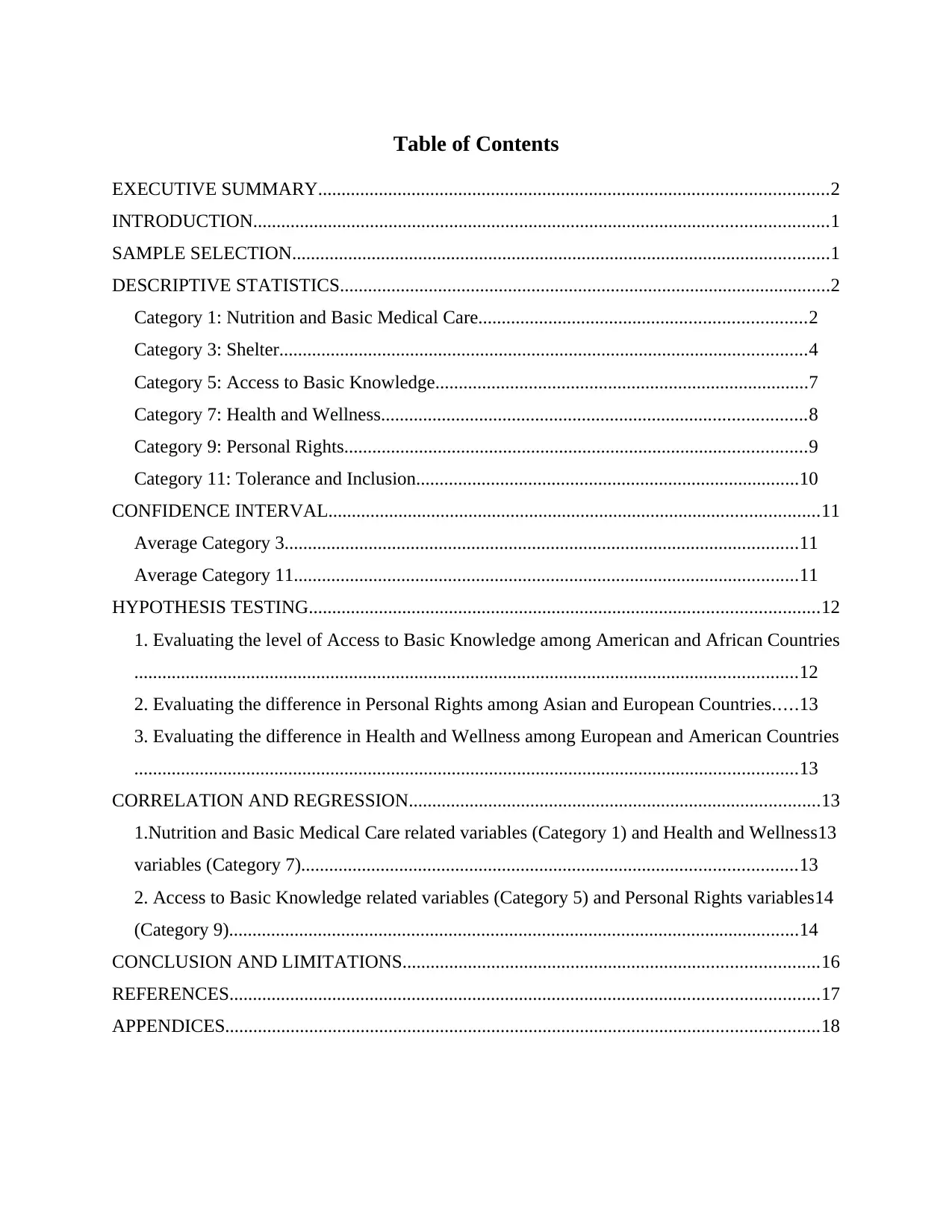
Table of Contents
EXECUTIVE SUMMARY.............................................................................................................2
INTRODUCTION...........................................................................................................................1
SAMPLE SELECTION...................................................................................................................1
DESCRIPTIVE STATISTICS.........................................................................................................2
Category 1: Nutrition and Basic Medical Care......................................................................2
Category 3: Shelter.................................................................................................................4
Category 5: Access to Basic Knowledge................................................................................7
Category 7: Health and Wellness...........................................................................................8
Category 9: Personal Rights...................................................................................................9
Category 11: Tolerance and Inclusion..................................................................................10
CONFIDENCE INTERVAL.........................................................................................................11
Average Category 3..............................................................................................................11
Average Category 11............................................................................................................11
HYPOTHESIS TESTING.............................................................................................................12
1. Evaluating the level of Access to Basic Knowledge among American and African Countries
..............................................................................................................................................12
2. Evaluating the difference in Personal Rights among Asian and European Countries.....13
3. Evaluating the difference in Health and Wellness among European and American Countries
..............................................................................................................................................13
CORRELATION AND REGRESSION........................................................................................13
1.Nutrition and Basic Medical Care related variables (Category 1) and Health and Wellness13
variables (Category 7)..........................................................................................................13
2. Access to Basic Knowledge related variables (Category 5) and Personal Rights variables14
(Category 9)..........................................................................................................................14
CONCLUSION AND LIMITATIONS.........................................................................................16
REFERENCES..............................................................................................................................17
APPENDICES...............................................................................................................................18
EXECUTIVE SUMMARY.............................................................................................................2
INTRODUCTION...........................................................................................................................1
SAMPLE SELECTION...................................................................................................................1
DESCRIPTIVE STATISTICS.........................................................................................................2
Category 1: Nutrition and Basic Medical Care......................................................................2
Category 3: Shelter.................................................................................................................4
Category 5: Access to Basic Knowledge................................................................................7
Category 7: Health and Wellness...........................................................................................8
Category 9: Personal Rights...................................................................................................9
Category 11: Tolerance and Inclusion..................................................................................10
CONFIDENCE INTERVAL.........................................................................................................11
Average Category 3..............................................................................................................11
Average Category 11............................................................................................................11
HYPOTHESIS TESTING.............................................................................................................12
1. Evaluating the level of Access to Basic Knowledge among American and African Countries
..............................................................................................................................................12
2. Evaluating the difference in Personal Rights among Asian and European Countries.....13
3. Evaluating the difference in Health and Wellness among European and American Countries
..............................................................................................................................................13
CORRELATION AND REGRESSION........................................................................................13
1.Nutrition and Basic Medical Care related variables (Category 1) and Health and Wellness13
variables (Category 7)..........................................................................................................13
2. Access to Basic Knowledge related variables (Category 5) and Personal Rights variables14
(Category 9)..........................................................................................................................14
CONCLUSION AND LIMITATIONS.........................................................................................16
REFERENCES..............................................................................................................................17
APPENDICES...............................................................................................................................18
You're viewing a preview
Unlock full access by subscribing today!
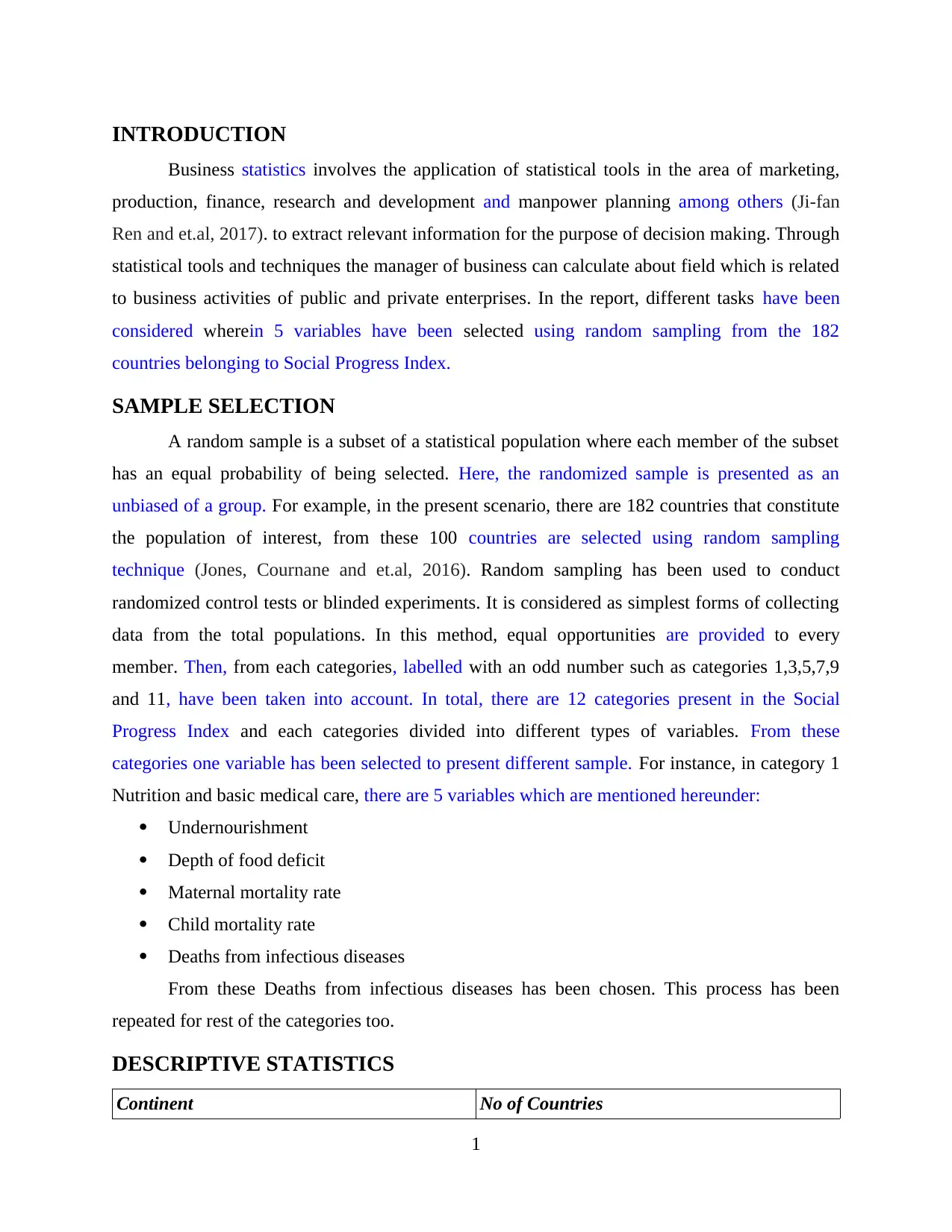
INTRODUCTION
Business statistics involves the application of statistical tools in the area of marketing,
production, finance, research and development and manpower planning among others (Ji-fan
Ren and et.al, 2017). to extract relevant information for the purpose of decision making. Through
statistical tools and techniques the manager of business can calculate about field which is related
to business activities of public and private enterprises. In the report, different tasks have been
considered wherein 5 variables have been selected using random sampling from the 182
countries belonging to Social Progress Index.
SAMPLE SELECTION
A random sample is a subset of a statistical population where each member of the subset
has an equal probability of being selected. Here, the randomized sample is presented as an
unbiased of a group. For example, in the present scenario, there are 182 countries that constitute
the population of interest, from these 100 countries are selected using random sampling
technique (Jones, Cournane and et.al, 2016). Random sampling has been used to conduct
randomized control tests or blinded experiments. It is considered as simplest forms of collecting
data from the total populations. In this method, equal opportunities are provided to every
member. Then, from each categories, labelled with an odd number such as categories 1,3,5,7,9
and 11, have been taken into account. In total, there are 12 categories present in the Social
Progress Index and each categories divided into different types of variables. From these
categories one variable has been selected to present different sample. For instance, in category 1
Nutrition and basic medical care, there are 5 variables which are mentioned hereunder:
Undernourishment
Depth of food deficit
Maternal mortality rate
Child mortality rate
Deaths from infectious diseases
From these Deaths from infectious diseases has been chosen. This process has been
repeated for rest of the categories too.
DESCRIPTIVE STATISTICS
Continent No of Countries
1
Business statistics involves the application of statistical tools in the area of marketing,
production, finance, research and development and manpower planning among others (Ji-fan
Ren and et.al, 2017). to extract relevant information for the purpose of decision making. Through
statistical tools and techniques the manager of business can calculate about field which is related
to business activities of public and private enterprises. In the report, different tasks have been
considered wherein 5 variables have been selected using random sampling from the 182
countries belonging to Social Progress Index.
SAMPLE SELECTION
A random sample is a subset of a statistical population where each member of the subset
has an equal probability of being selected. Here, the randomized sample is presented as an
unbiased of a group. For example, in the present scenario, there are 182 countries that constitute
the population of interest, from these 100 countries are selected using random sampling
technique (Jones, Cournane and et.al, 2016). Random sampling has been used to conduct
randomized control tests or blinded experiments. It is considered as simplest forms of collecting
data from the total populations. In this method, equal opportunities are provided to every
member. Then, from each categories, labelled with an odd number such as categories 1,3,5,7,9
and 11, have been taken into account. In total, there are 12 categories present in the Social
Progress Index and each categories divided into different types of variables. From these
categories one variable has been selected to present different sample. For instance, in category 1
Nutrition and basic medical care, there are 5 variables which are mentioned hereunder:
Undernourishment
Depth of food deficit
Maternal mortality rate
Child mortality rate
Deaths from infectious diseases
From these Deaths from infectious diseases has been chosen. This process has been
repeated for rest of the categories too.
DESCRIPTIVE STATISTICS
Continent No of Countries
1
Paraphrase This Document
Need a fresh take? Get an instant paraphrase of this document with our AI Paraphraser
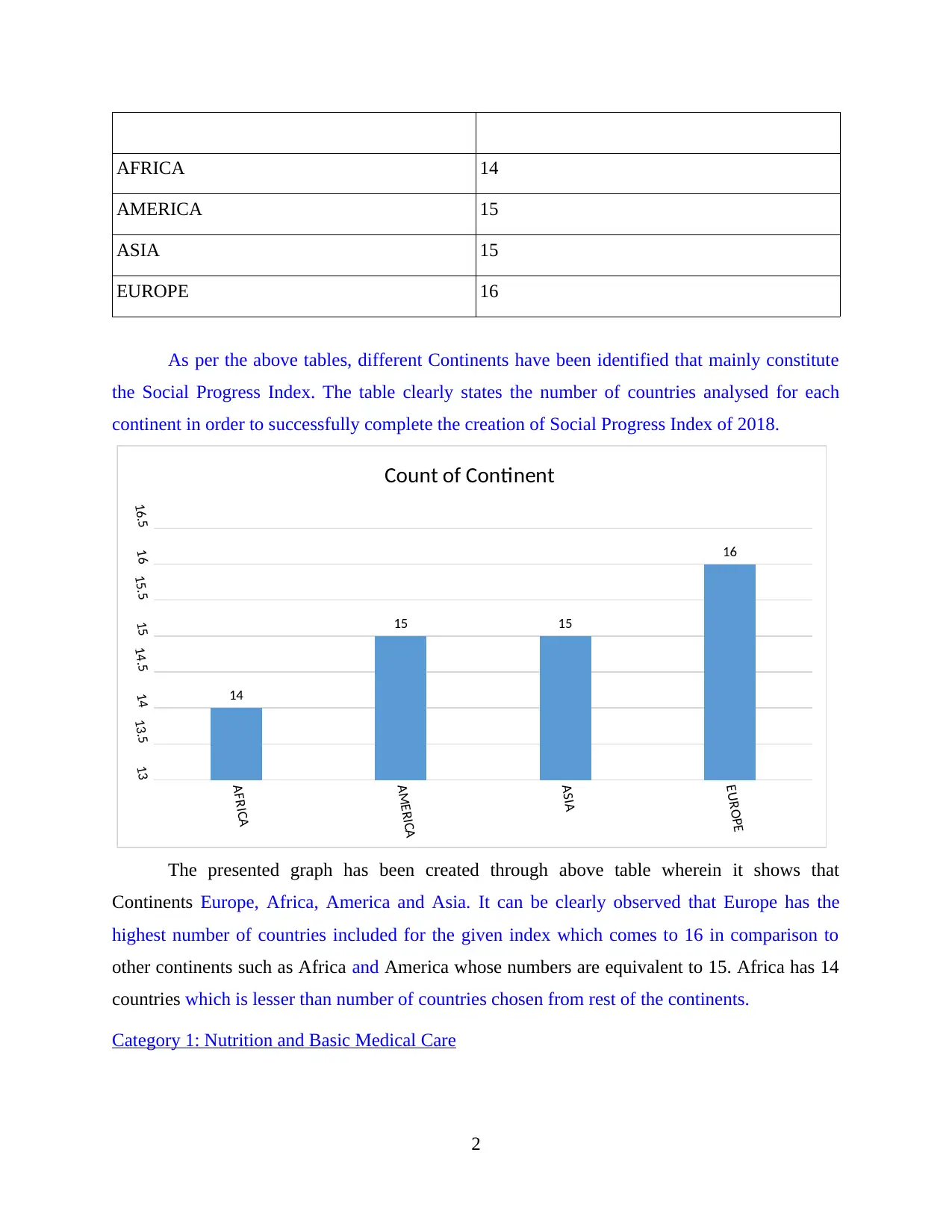
AFRICA 14
AMERICA 15
ASIA 15
EUROPE 16
As per the above tables, different Continents have been identified that mainly constitute
the Social Progress Index. The table clearly states the number of countries analysed for each
continent in order to successfully complete the creation of Social Progress Index of 2018.
AFRICA
AMERICA
ASIA
EUROPE
1313.51414.51515.51616.5
14
15 15
16
Count of Continent
The presented graph has been created through above table wherein it shows that
Continents Europe, Africa, America and Asia. It can be clearly observed that Europe has the
highest number of countries included for the given index which comes to 16 in comparison to
other continents such as Africa and America whose numbers are equivalent to 15. Africa has 14
countries which is lesser than number of countries chosen from rest of the continents.
Category 1: Nutrition and Basic Medical Care
2
AMERICA 15
ASIA 15
EUROPE 16
As per the above tables, different Continents have been identified that mainly constitute
the Social Progress Index. The table clearly states the number of countries analysed for each
continent in order to successfully complete the creation of Social Progress Index of 2018.
AFRICA
AMERICA
ASIA
EUROPE
1313.51414.51515.51616.5
14
15 15
16
Count of Continent
The presented graph has been created through above table wherein it shows that
Continents Europe, Africa, America and Asia. It can be clearly observed that Europe has the
highest number of countries included for the given index which comes to 16 in comparison to
other continents such as Africa and America whose numbers are equivalent to 15. Africa has 14
countries which is lesser than number of countries chosen from rest of the continents.
Category 1: Nutrition and Basic Medical Care
2
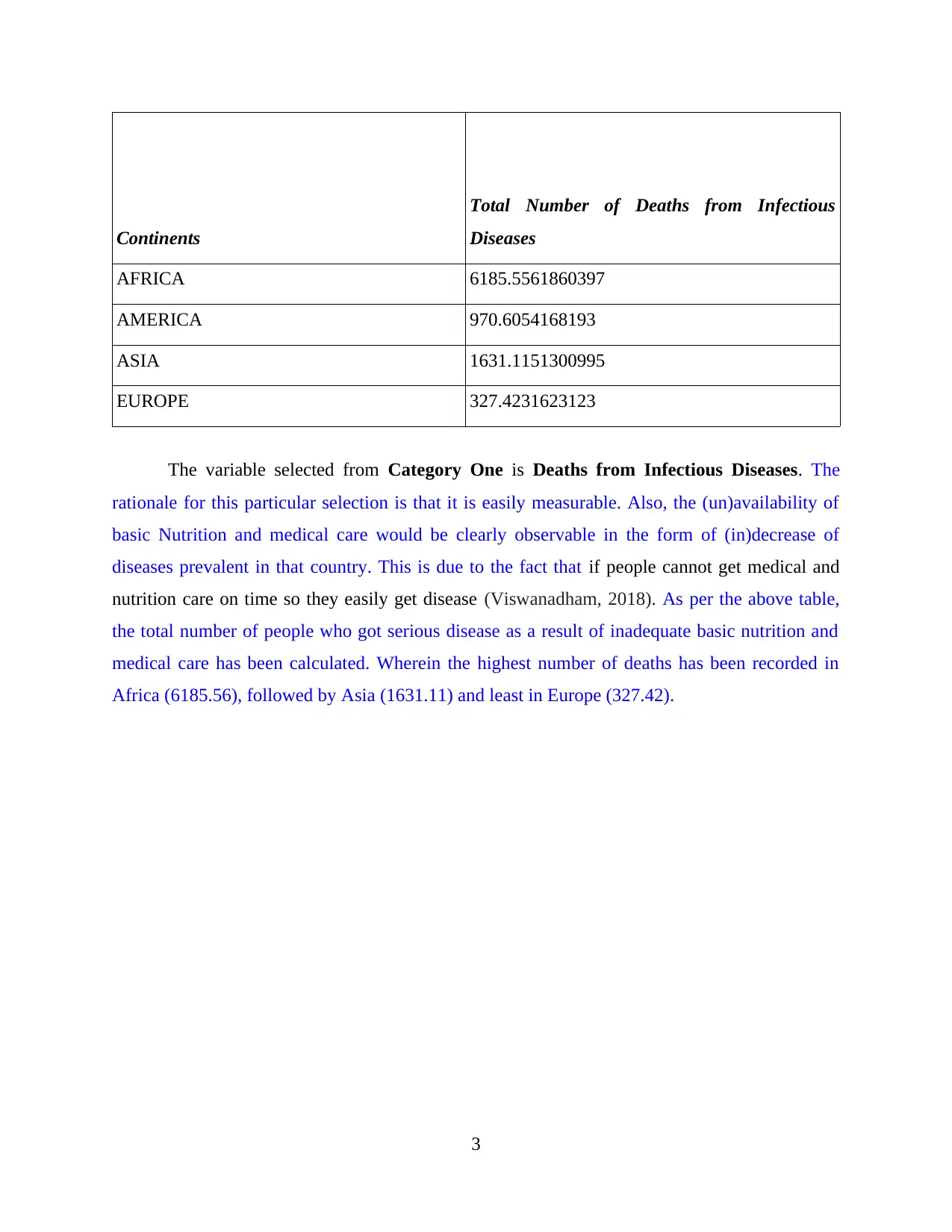
Continents
Total Number of Deaths from Infectious
Diseases
AFRICA 6185.5561860397
AMERICA 970.6054168193
ASIA 1631.1151300995
EUROPE 327.4231623123
The variable selected from Category One is Deaths from Infectious Diseases. The
rationale for this particular selection is that it is easily measurable. Also, the (un)availability of
basic Nutrition and medical care would be clearly observable in the form of (in)decrease of
diseases prevalent in that country. This is due to the fact that if people cannot get medical and
nutrition care on time so they easily get disease (Viswanadham, 2018). As per the above table,
the total number of people who got serious disease as a result of inadequate basic nutrition and
medical care has been calculated. Wherein the highest number of deaths has been recorded in
Africa (6185.56), followed by Asia (1631.11) and least in Europe (327.42).
3
Total Number of Deaths from Infectious
Diseases
AFRICA 6185.5561860397
AMERICA 970.6054168193
ASIA 1631.1151300995
EUROPE 327.4231623123
The variable selected from Category One is Deaths from Infectious Diseases. The
rationale for this particular selection is that it is easily measurable. Also, the (un)availability of
basic Nutrition and medical care would be clearly observable in the form of (in)decrease of
diseases prevalent in that country. This is due to the fact that if people cannot get medical and
nutrition care on time so they easily get disease (Viswanadham, 2018). As per the above table,
the total number of people who got serious disease as a result of inadequate basic nutrition and
medical care has been calculated. Wherein the highest number of deaths has been recorded in
Africa (6185.56), followed by Asia (1631.11) and least in Europe (327.42).
3
You're viewing a preview
Unlock full access by subscribing today!
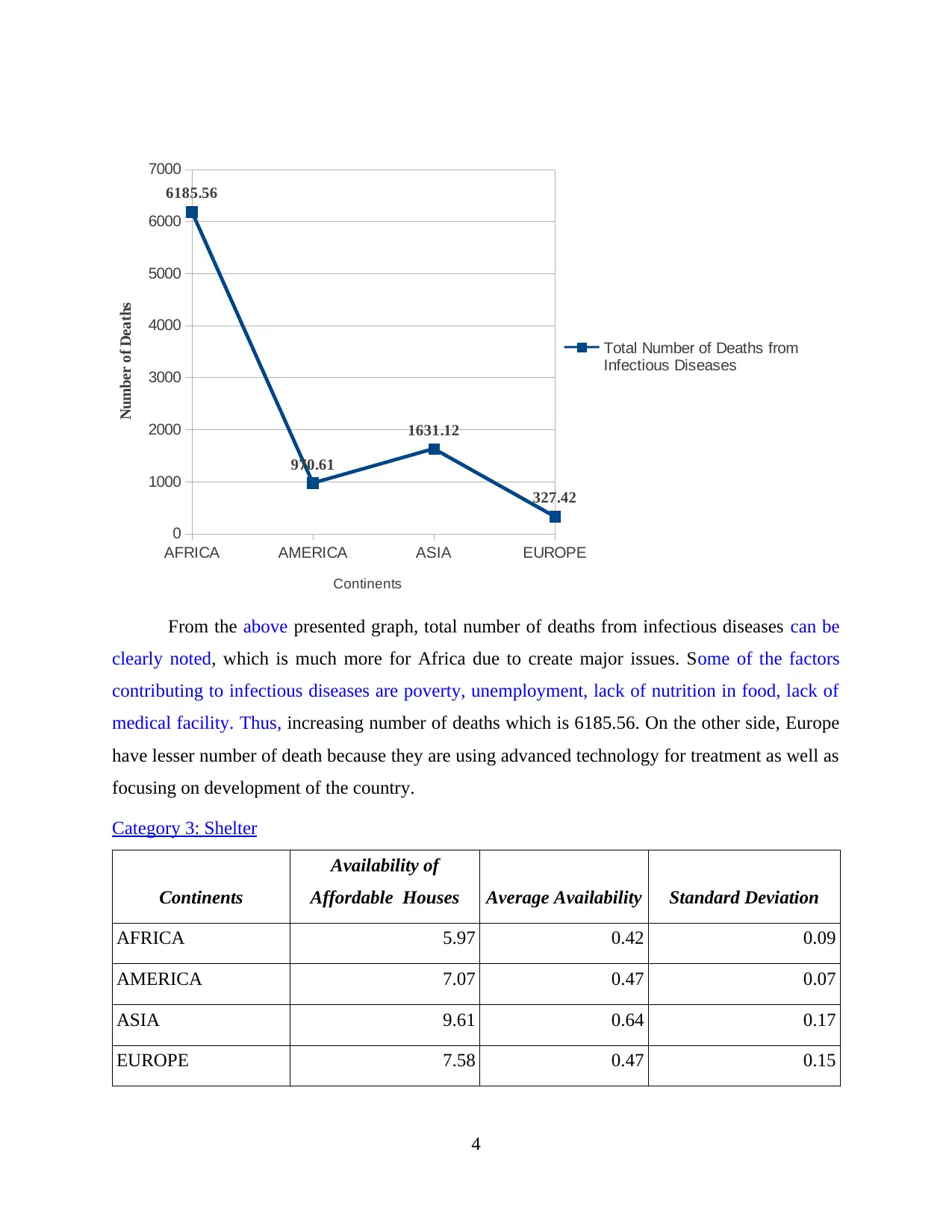
AFRICA AMERICA ASIA EUROPE
0
1000
2000
3000
4000
5000
6000
7000
6185.56
970.61
1631.12
327.42
Total Number of Deaths from
Infectious Diseases
Continents
Number of Deaths
From the above presented graph, total number of deaths from infectious diseases can be
clearly noted, which is much more for Africa due to create major issues. Some of the factors
contributing to infectious diseases are poverty, unemployment, lack of nutrition in food, lack of
medical facility. Thus, increasing number of deaths which is 6185.56. On the other side, Europe
have lesser number of death because they are using advanced technology for treatment as well as
focusing on development of the country.
Category 3: Shelter
Continents
Availability of
Affordable Houses Average Availability Standard Deviation
AFRICA 5.97 0.42 0.09
AMERICA 7.07 0.47 0.07
ASIA 9.61 0.64 0.17
EUROPE 7.58 0.47 0.15
4
0
1000
2000
3000
4000
5000
6000
7000
6185.56
970.61
1631.12
327.42
Total Number of Deaths from
Infectious Diseases
Continents
Number of Deaths
From the above presented graph, total number of deaths from infectious diseases can be
clearly noted, which is much more for Africa due to create major issues. Some of the factors
contributing to infectious diseases are poverty, unemployment, lack of nutrition in food, lack of
medical facility. Thus, increasing number of deaths which is 6185.56. On the other side, Europe
have lesser number of death because they are using advanced technology for treatment as well as
focusing on development of the country.
Category 3: Shelter
Continents
Availability of
Affordable Houses Average Availability Standard Deviation
AFRICA 5.97 0.42 0.09
AMERICA 7.07 0.47 0.07
ASIA 9.61 0.64 0.17
EUROPE 7.58 0.47 0.15
4
Paraphrase This Document
Need a fresh take? Get an instant paraphrase of this document with our AI Paraphraser
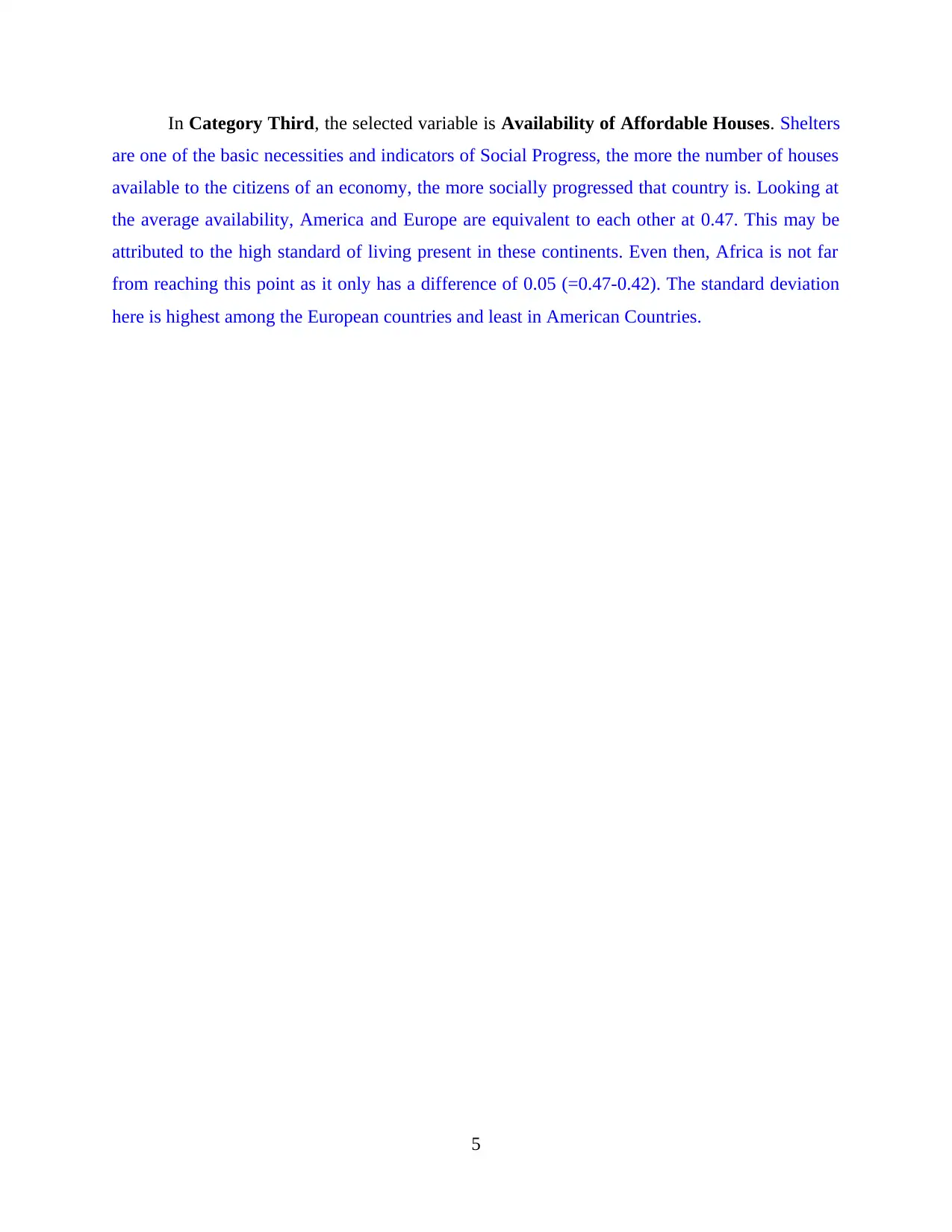
In Category Third, the selected variable is Availability of Affordable Houses. Shelters
are one of the basic necessities and indicators of Social Progress, the more the number of houses
available to the citizens of an economy, the more socially progressed that country is. Looking at
the average availability, America and Europe are equivalent to each other at 0.47. This may be
attributed to the high standard of living present in these continents. Even then, Africa is not far
from reaching this point as it only has a difference of 0.05 (=0.47-0.42). The standard deviation
here is highest among the European countries and least in American Countries.
5
are one of the basic necessities and indicators of Social Progress, the more the number of houses
available to the citizens of an economy, the more socially progressed that country is. Looking at
the average availability, America and Europe are equivalent to each other at 0.47. This may be
attributed to the high standard of living present in these continents. Even then, Africa is not far
from reaching this point as it only has a difference of 0.05 (=0.47-0.42). The standard deviation
here is highest among the European countries and least in American Countries.
5
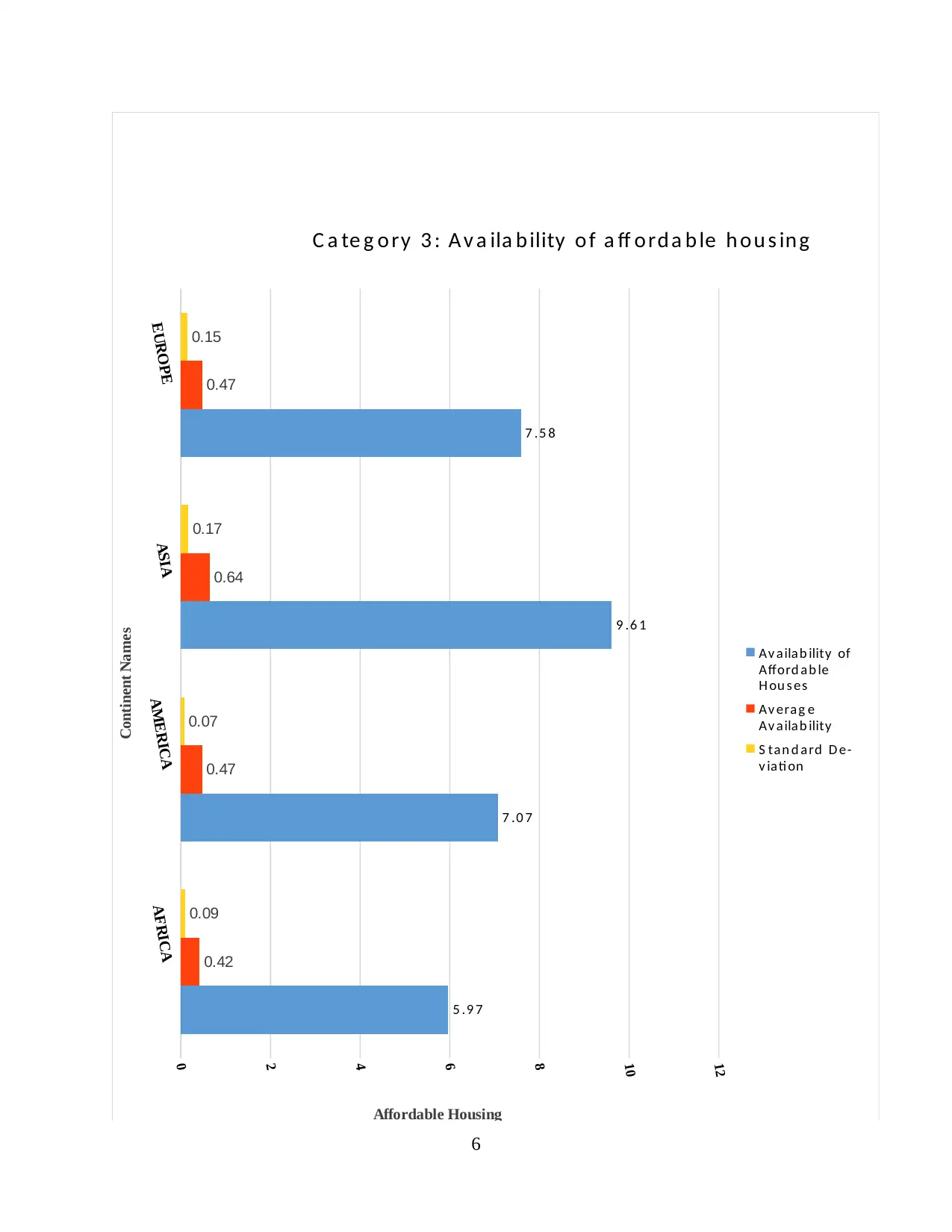
AFRICA
AMERICA
ASIA
EUROPE
0
2
4
6
8
10
12
5 .9 7
7 .0 7
9 .6 1
7 .5 8
0.42
0.47
0.64
0.47
0.09
0.07
0.17
0.15
C a te g o ry 3 : A v a ila b ility o f a ff o rd a b le h o u s in g
Av aila b ility of
Afford a b le
H ou s es
Av erag e
Av aila b ility
S tan d a rd D e-
v iati on
Affordable Housing
Continent Names
6
AMERICA
ASIA
EUROPE
0
2
4
6
8
10
12
5 .9 7
7 .0 7
9 .6 1
7 .5 8
0.42
0.47
0.64
0.47
0.09
0.07
0.17
0.15
C a te g o ry 3 : A v a ila b ility o f a ff o rd a b le h o u s in g
Av aila b ility of
Afford a b le
H ou s es
Av erag e
Av aila b ility
S tan d a rd D e-
v iati on
Affordable Housing
Continent Names
6
You're viewing a preview
Unlock full access by subscribing today!
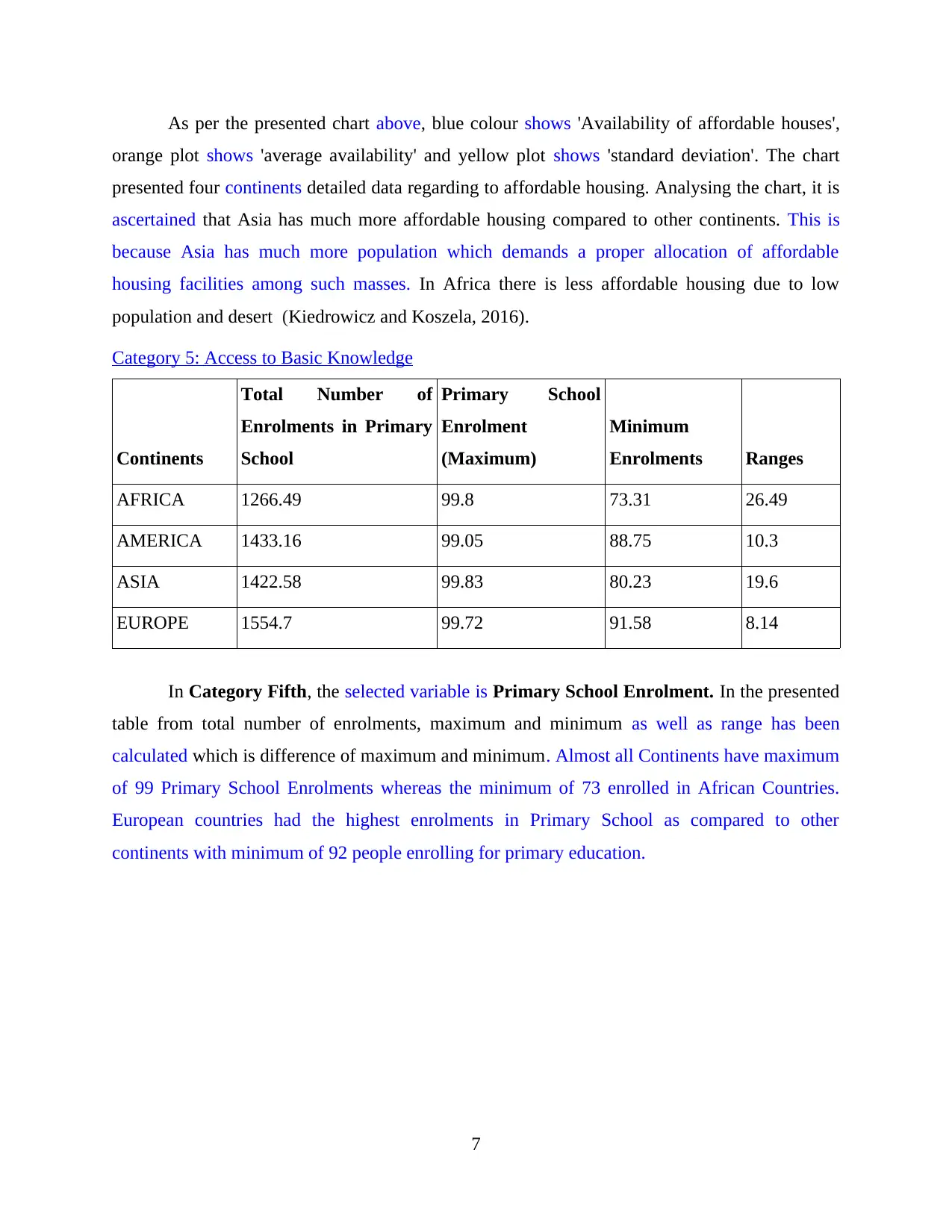
As per the presented chart above, blue colour shows 'Availability of affordable houses',
orange plot shows 'average availability' and yellow plot shows 'standard deviation'. The chart
presented four continents detailed data regarding to affordable housing. Analysing the chart, it is
ascertained that Asia has much more affordable housing compared to other continents. This is
because Asia has much more population which demands a proper allocation of affordable
housing facilities among such masses. In Africa there is less affordable housing due to low
population and desert (Kiedrowicz and Koszela, 2016).
Category 5: Access to Basic Knowledge
Continents
Total Number of
Enrolments in Primary
School
Primary School
Enrolment
(Maximum)
Minimum
Enrolments Ranges
AFRICA 1266.49 99.8 73.31 26.49
AMERICA 1433.16 99.05 88.75 10.3
ASIA 1422.58 99.83 80.23 19.6
EUROPE 1554.7 99.72 91.58 8.14
In Category Fifth, the selected variable is Primary School Enrolment. In the presented
table from total number of enrolments, maximum and minimum as well as range has been
calculated which is difference of maximum and minimum. Almost all Continents have maximum
of 99 Primary School Enrolments whereas the minimum of 73 enrolled in African Countries.
European countries had the highest enrolments in Primary School as compared to other
continents with minimum of 92 people enrolling for primary education.
7
orange plot shows 'average availability' and yellow plot shows 'standard deviation'. The chart
presented four continents detailed data regarding to affordable housing. Analysing the chart, it is
ascertained that Asia has much more affordable housing compared to other continents. This is
because Asia has much more population which demands a proper allocation of affordable
housing facilities among such masses. In Africa there is less affordable housing due to low
population and desert (Kiedrowicz and Koszela, 2016).
Category 5: Access to Basic Knowledge
Continents
Total Number of
Enrolments in Primary
School
Primary School
Enrolment
(Maximum)
Minimum
Enrolments Ranges
AFRICA 1266.49 99.8 73.31 26.49
AMERICA 1433.16 99.05 88.75 10.3
ASIA 1422.58 99.83 80.23 19.6
EUROPE 1554.7 99.72 91.58 8.14
In Category Fifth, the selected variable is Primary School Enrolment. In the presented
table from total number of enrolments, maximum and minimum as well as range has been
calculated which is difference of maximum and minimum. Almost all Continents have maximum
of 99 Primary School Enrolments whereas the minimum of 73 enrolled in African Countries.
European countries had the highest enrolments in Primary School as compared to other
continents with minimum of 92 people enrolling for primary education.
7
Paraphrase This Document
Need a fresh take? Get an instant paraphrase of this document with our AI Paraphraser
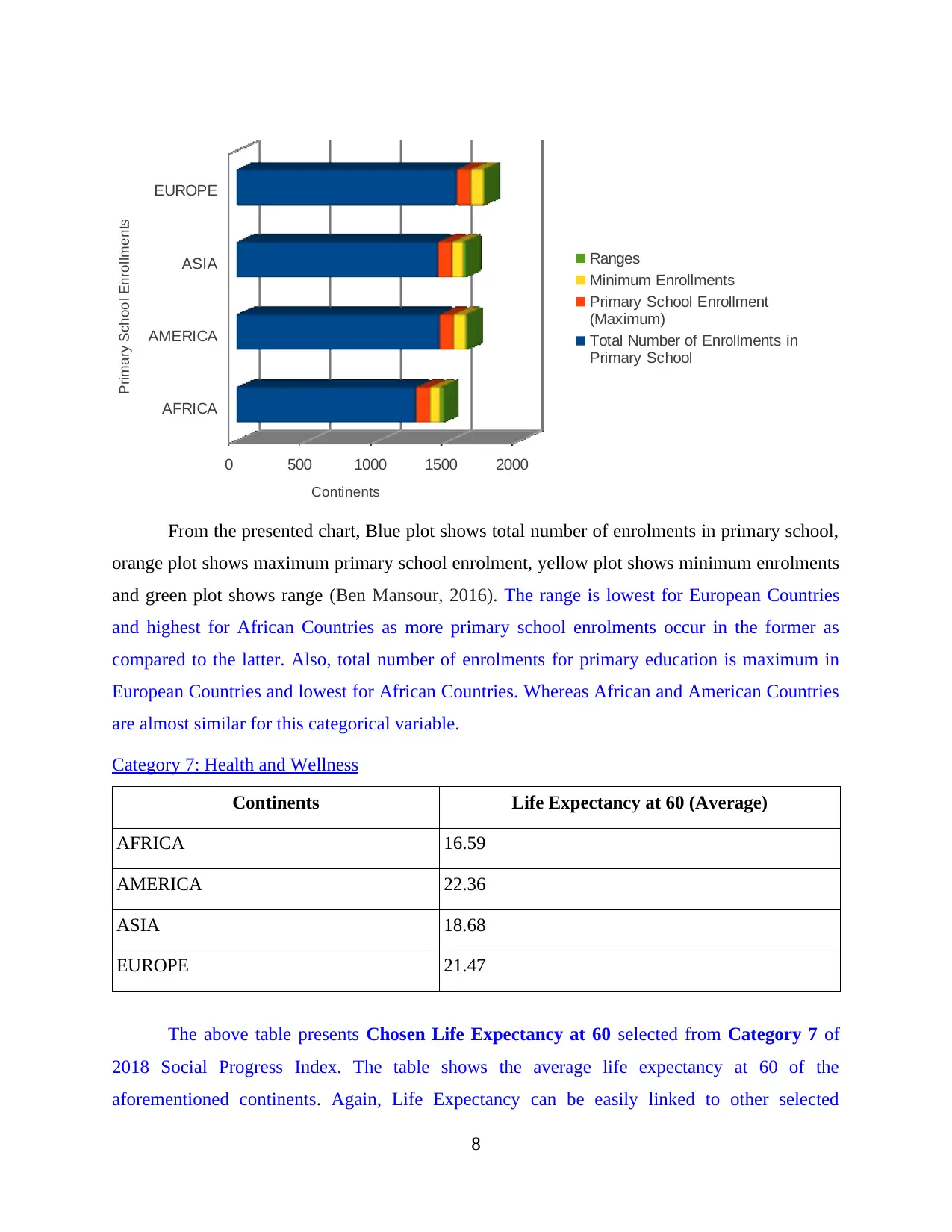
AFRICA
AMERICA
ASIA
EUROPE
0 500 1000 1500 2000
Ranges
Minimum Enrollments
Primary School Enrollment
(Maximum)
Total Number of Enrollments in
Primary School
Continents
Primary School Enrollments
From the presented chart, Blue plot shows total number of enrolments in primary school,
orange plot shows maximum primary school enrolment, yellow plot shows minimum enrolments
and green plot shows range (Ben Mansour, 2016). The range is lowest for European Countries
and highest for African Countries as more primary school enrolments occur in the former as
compared to the latter. Also, total number of enrolments for primary education is maximum in
European Countries and lowest for African Countries. Whereas African and American Countries
are almost similar for this categorical variable.
Category 7: Health and Wellness
Continents Life Expectancy at 60 (Average)
AFRICA 16.59
AMERICA 22.36
ASIA 18.68
EUROPE 21.47
The above table presents Chosen Life Expectancy at 60 selected from Category 7 of
2018 Social Progress Index. The table shows the average life expectancy at 60 of the
aforementioned continents. Again, Life Expectancy can be easily linked to other selected
8
AMERICA
ASIA
EUROPE
0 500 1000 1500 2000
Ranges
Minimum Enrollments
Primary School Enrollment
(Maximum)
Total Number of Enrollments in
Primary School
Continents
Primary School Enrollments
From the presented chart, Blue plot shows total number of enrolments in primary school,
orange plot shows maximum primary school enrolment, yellow plot shows minimum enrolments
and green plot shows range (Ben Mansour, 2016). The range is lowest for European Countries
and highest for African Countries as more primary school enrolments occur in the former as
compared to the latter. Also, total number of enrolments for primary education is maximum in
European Countries and lowest for African Countries. Whereas African and American Countries
are almost similar for this categorical variable.
Category 7: Health and Wellness
Continents Life Expectancy at 60 (Average)
AFRICA 16.59
AMERICA 22.36
ASIA 18.68
EUROPE 21.47
The above table presents Chosen Life Expectancy at 60 selected from Category 7 of
2018 Social Progress Index. The table shows the average life expectancy at 60 of the
aforementioned continents. Again, Life Expectancy can be easily linked to other selected
8
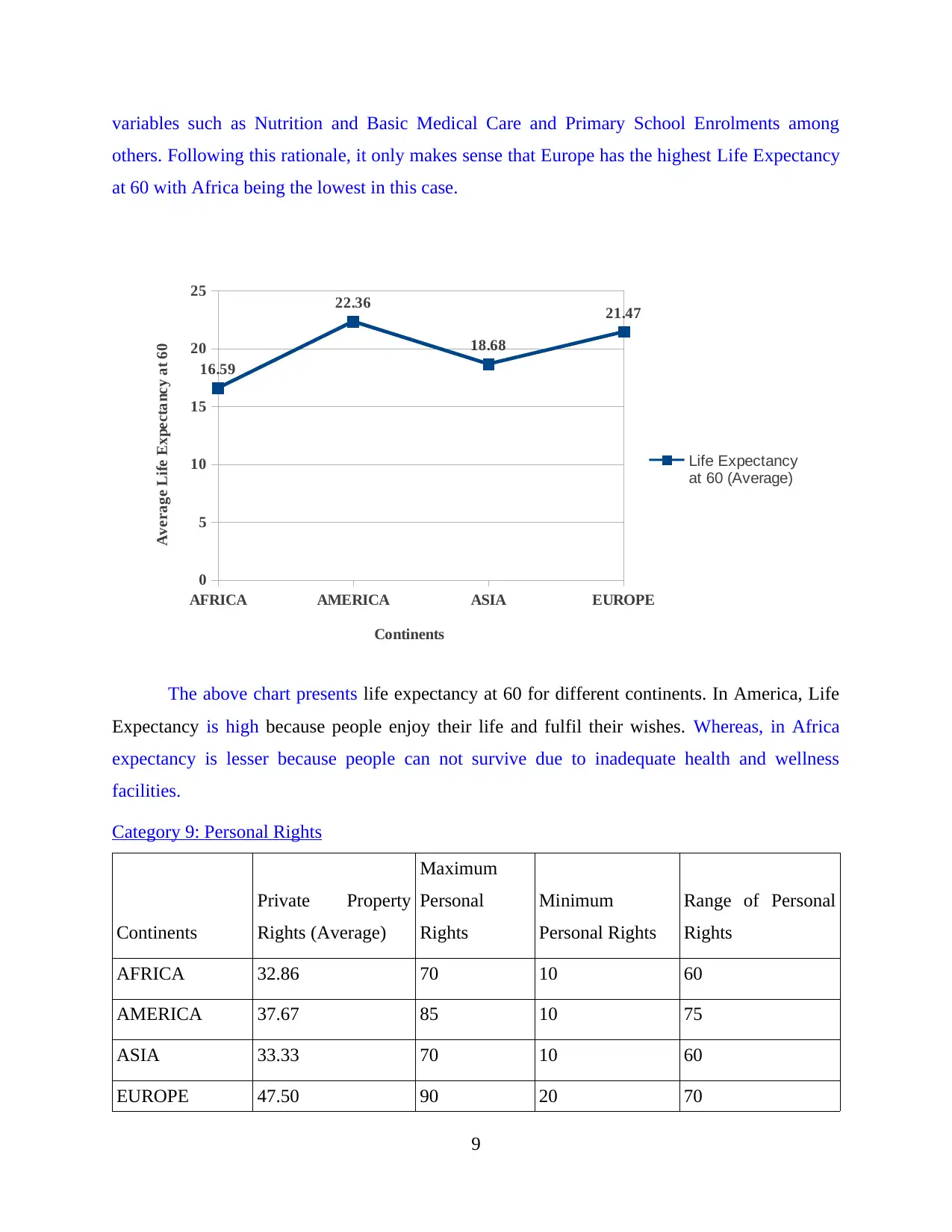
variables such as Nutrition and Basic Medical Care and Primary School Enrolments among
others. Following this rationale, it only makes sense that Europe has the highest Life Expectancy
at 60 with Africa being the lowest in this case.
AFRICA AMERICA ASIA EUROPE
0
5
10
15
20
25
16.59
22.36
18.68
21.47
Life Expectancy
at 60 (Average)
Continents
Average Life Expectancy at 60
The above chart presents life expectancy at 60 for different continents. In America, Life
Expectancy is high because people enjoy their life and fulfil their wishes. Whereas, in Africa
expectancy is lesser because people can not survive due to inadequate health and wellness
facilities.
Category 9: Personal Rights
Continents
Private Property
Rights (Average)
Maximum
Personal
Rights
Minimum
Personal Rights
Range of Personal
Rights
AFRICA 32.86 70 10 60
AMERICA 37.67 85 10 75
ASIA 33.33 70 10 60
EUROPE 47.50 90 20 70
9
others. Following this rationale, it only makes sense that Europe has the highest Life Expectancy
at 60 with Africa being the lowest in this case.
AFRICA AMERICA ASIA EUROPE
0
5
10
15
20
25
16.59
22.36
18.68
21.47
Life Expectancy
at 60 (Average)
Continents
Average Life Expectancy at 60
The above chart presents life expectancy at 60 for different continents. In America, Life
Expectancy is high because people enjoy their life and fulfil their wishes. Whereas, in Africa
expectancy is lesser because people can not survive due to inadequate health and wellness
facilities.
Category 9: Personal Rights
Continents
Private Property
Rights (Average)
Maximum
Personal
Rights
Minimum
Personal Rights
Range of Personal
Rights
AFRICA 32.86 70 10 60
AMERICA 37.67 85 10 75
ASIA 33.33 70 10 60
EUROPE 47.50 90 20 70
9
You're viewing a preview
Unlock full access by subscribing today!
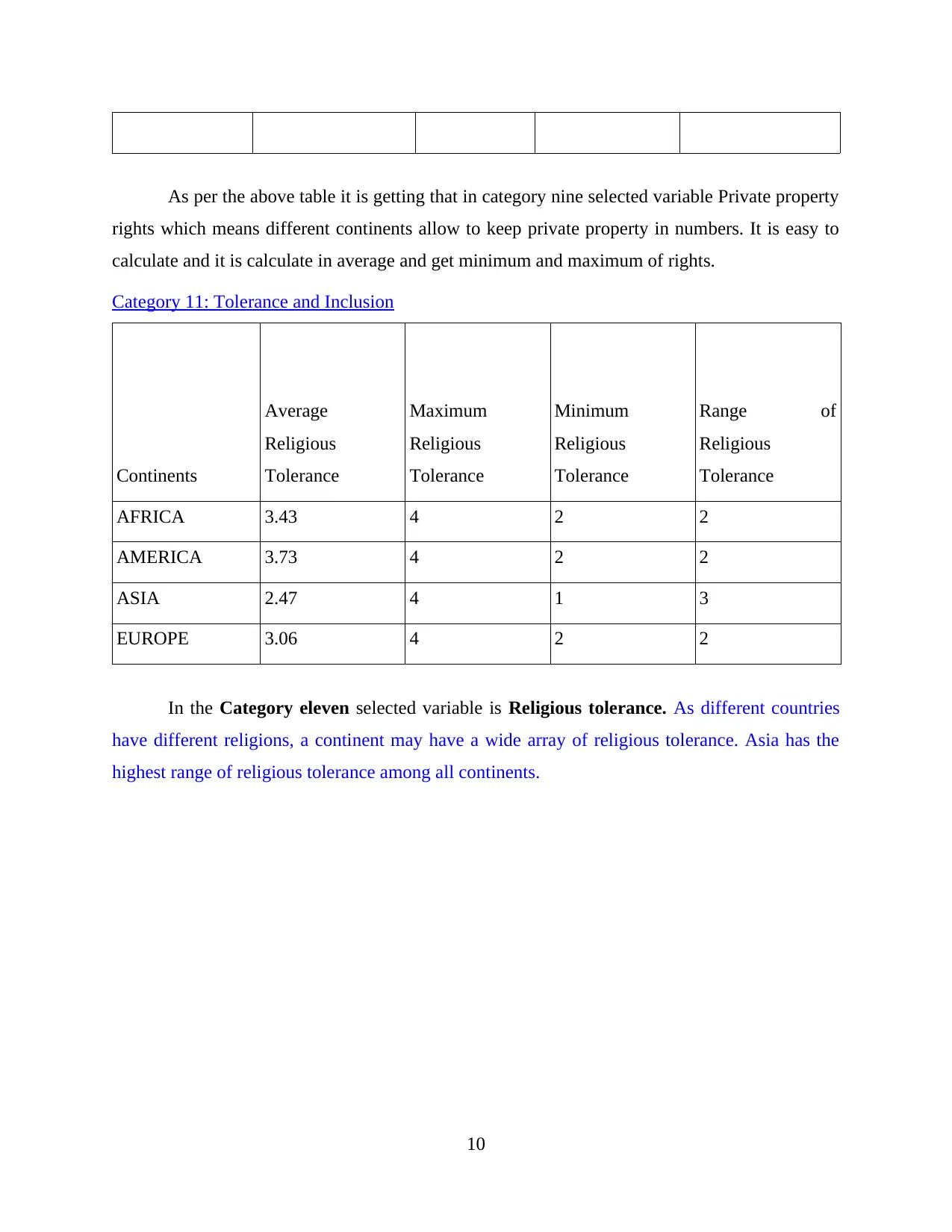
As per the above table it is getting that in category nine selected variable Private property
rights which means different continents allow to keep private property in numbers. It is easy to
calculate and it is calculate in average and get minimum and maximum of rights.
Category 11: Tolerance and Inclusion
Continents
Average
Religious
Tolerance
Maximum
Religious
Tolerance
Minimum
Religious
Tolerance
Range of
Religious
Tolerance
AFRICA 3.43 4 2 2
AMERICA 3.73 4 2 2
ASIA 2.47 4 1 3
EUROPE 3.06 4 2 2
In the Category eleven selected variable is Religious tolerance. As different countries
have different religions, a continent may have a wide array of religious tolerance. Asia has the
highest range of religious tolerance among all continents.
10
rights which means different continents allow to keep private property in numbers. It is easy to
calculate and it is calculate in average and get minimum and maximum of rights.
Category 11: Tolerance and Inclusion
Continents
Average
Religious
Tolerance
Maximum
Religious
Tolerance
Minimum
Religious
Tolerance
Range of
Religious
Tolerance
AFRICA 3.43 4 2 2
AMERICA 3.73 4 2 2
ASIA 2.47 4 1 3
EUROPE 3.06 4 2 2
In the Category eleven selected variable is Religious tolerance. As different countries
have different religions, a continent may have a wide array of religious tolerance. Asia has the
highest range of religious tolerance among all continents.
10
Paraphrase This Document
Need a fresh take? Get an instant paraphrase of this document with our AI Paraphraser
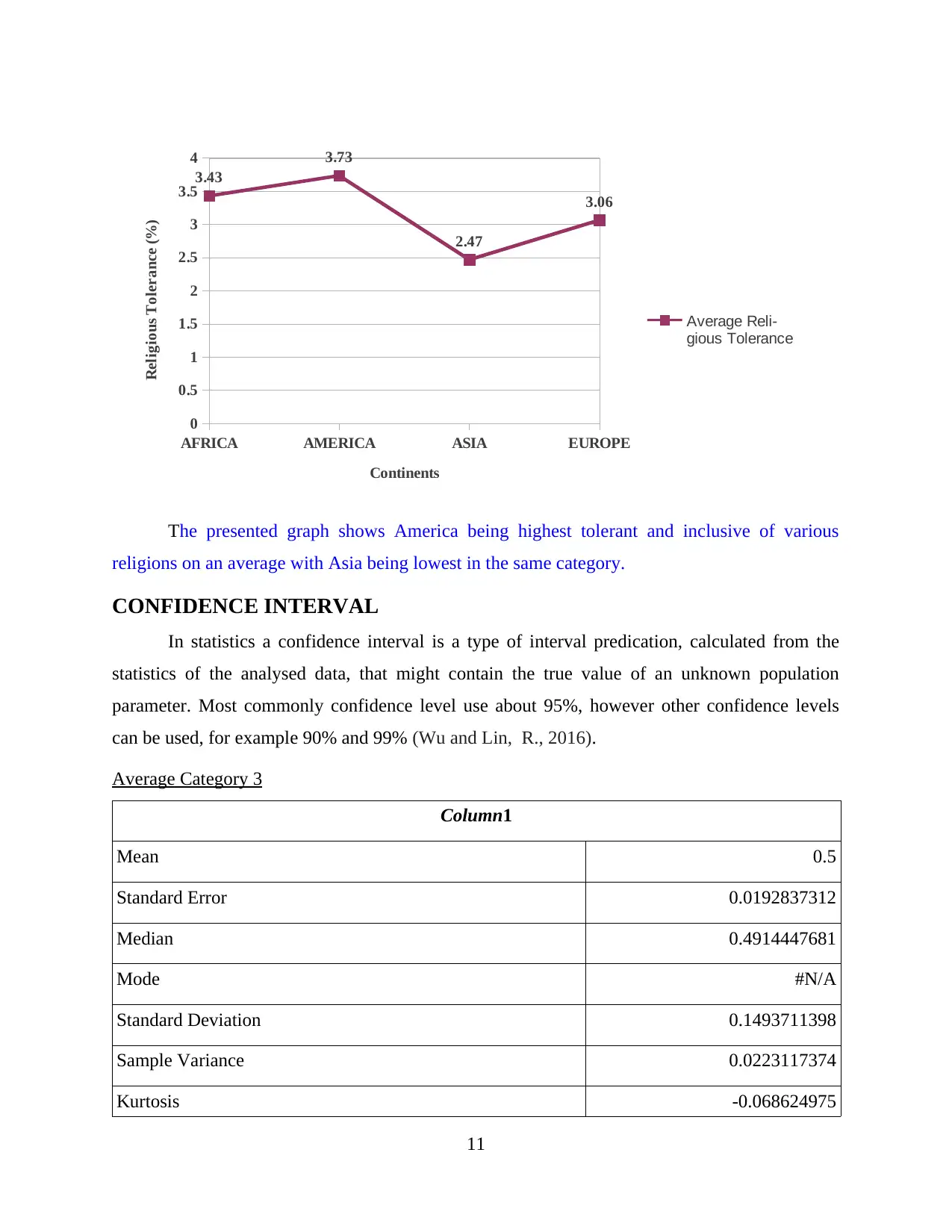
AFRICA AMERICA ASIA EUROPE
0
0.5
1
1.5
2
2.5
3
3.5
4
3.43
3.73
2.47
3.06
Average Reli-
gious Tolerance
Continents
Religious Tolerance (%)
The presented graph shows America being highest tolerant and inclusive of various
religions on an average with Asia being lowest in the same category.
CONFIDENCE INTERVAL
In statistics a confidence interval is a type of interval predication, calculated from the
statistics of the analysed data, that might contain the true value of an unknown population
parameter. Most commonly confidence level use about 95%, however other confidence levels
can be used, for example 90% and 99% (Wu and Lin, R., 2016).
Average Category 3
Column1
Mean 0.5
Standard Error 0.0192837312
Median 0.4914447681
Mode #N/A
Standard Deviation 0.1493711398
Sample Variance 0.0223117374
Kurtosis -0.068624975
11
0
0.5
1
1.5
2
2.5
3
3.5
4
3.43
3.73
2.47
3.06
Average Reli-
gious Tolerance
Continents
Religious Tolerance (%)
The presented graph shows America being highest tolerant and inclusive of various
religions on an average with Asia being lowest in the same category.
CONFIDENCE INTERVAL
In statistics a confidence interval is a type of interval predication, calculated from the
statistics of the analysed data, that might contain the true value of an unknown population
parameter. Most commonly confidence level use about 95%, however other confidence levels
can be used, for example 90% and 99% (Wu and Lin, R., 2016).
Average Category 3
Column1
Mean 0.5
Standard Error 0.0192837312
Median 0.4914447681
Mode #N/A
Standard Deviation 0.1493711398
Sample Variance 0.0223117374
Kurtosis -0.068624975
11
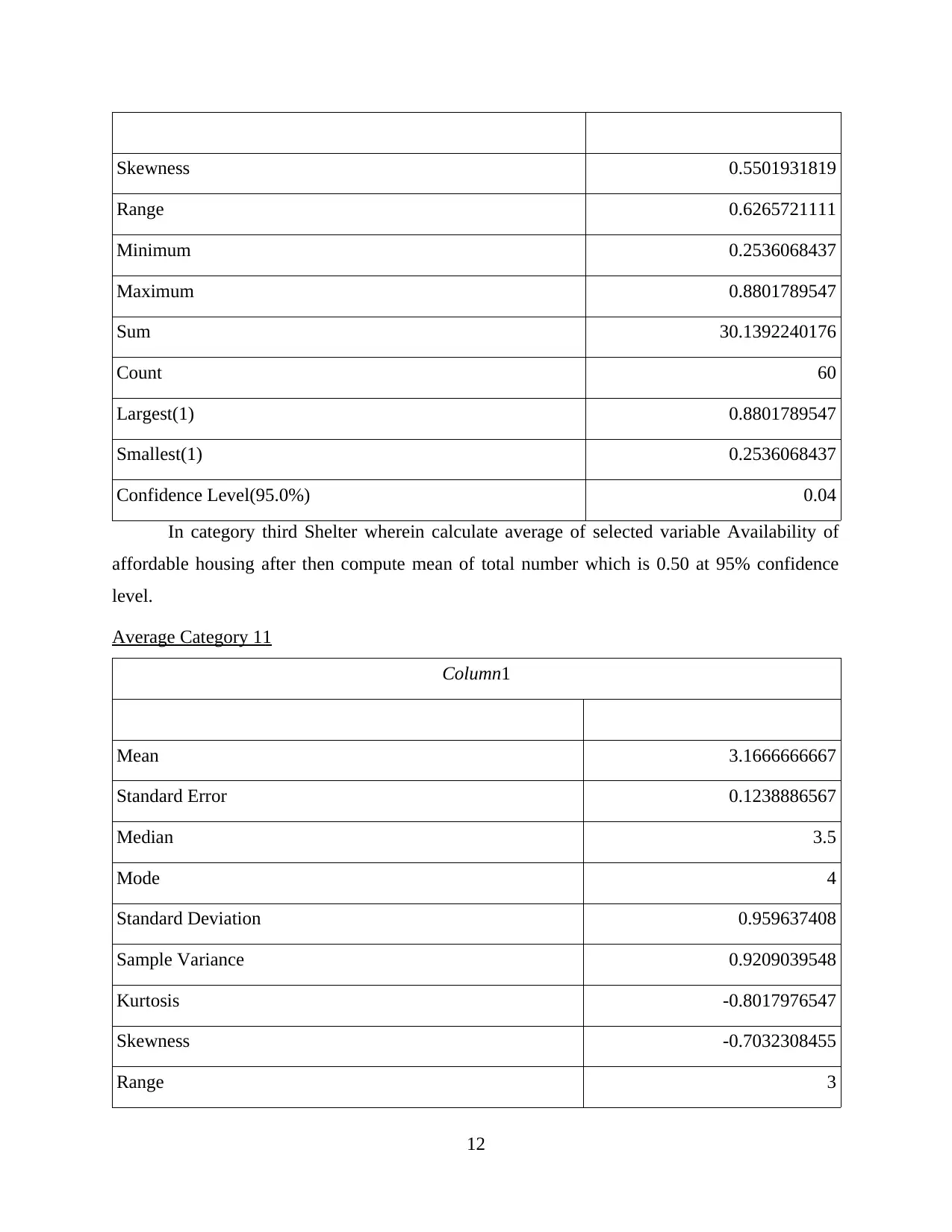
Skewness 0.5501931819
Range 0.6265721111
Minimum 0.2536068437
Maximum 0.8801789547
Sum 30.1392240176
Count 60
Largest(1) 0.8801789547
Smallest(1) 0.2536068437
Confidence Level(95.0%) 0.04
In category third Shelter wherein calculate average of selected variable Availability of
affordable housing after then compute mean of total number which is 0.50 at 95% confidence
level.
Average Category 11
Column1
Mean 3.1666666667
Standard Error 0.1238886567
Median 3.5
Mode 4
Standard Deviation 0.959637408
Sample Variance 0.9209039548
Kurtosis -0.8017976547
Skewness -0.7032308455
Range 3
12
Range 0.6265721111
Minimum 0.2536068437
Maximum 0.8801789547
Sum 30.1392240176
Count 60
Largest(1) 0.8801789547
Smallest(1) 0.2536068437
Confidence Level(95.0%) 0.04
In category third Shelter wherein calculate average of selected variable Availability of
affordable housing after then compute mean of total number which is 0.50 at 95% confidence
level.
Average Category 11
Column1
Mean 3.1666666667
Standard Error 0.1238886567
Median 3.5
Mode 4
Standard Deviation 0.959637408
Sample Variance 0.9209039548
Kurtosis -0.8017976547
Skewness -0.7032308455
Range 3
12
You're viewing a preview
Unlock full access by subscribing today!
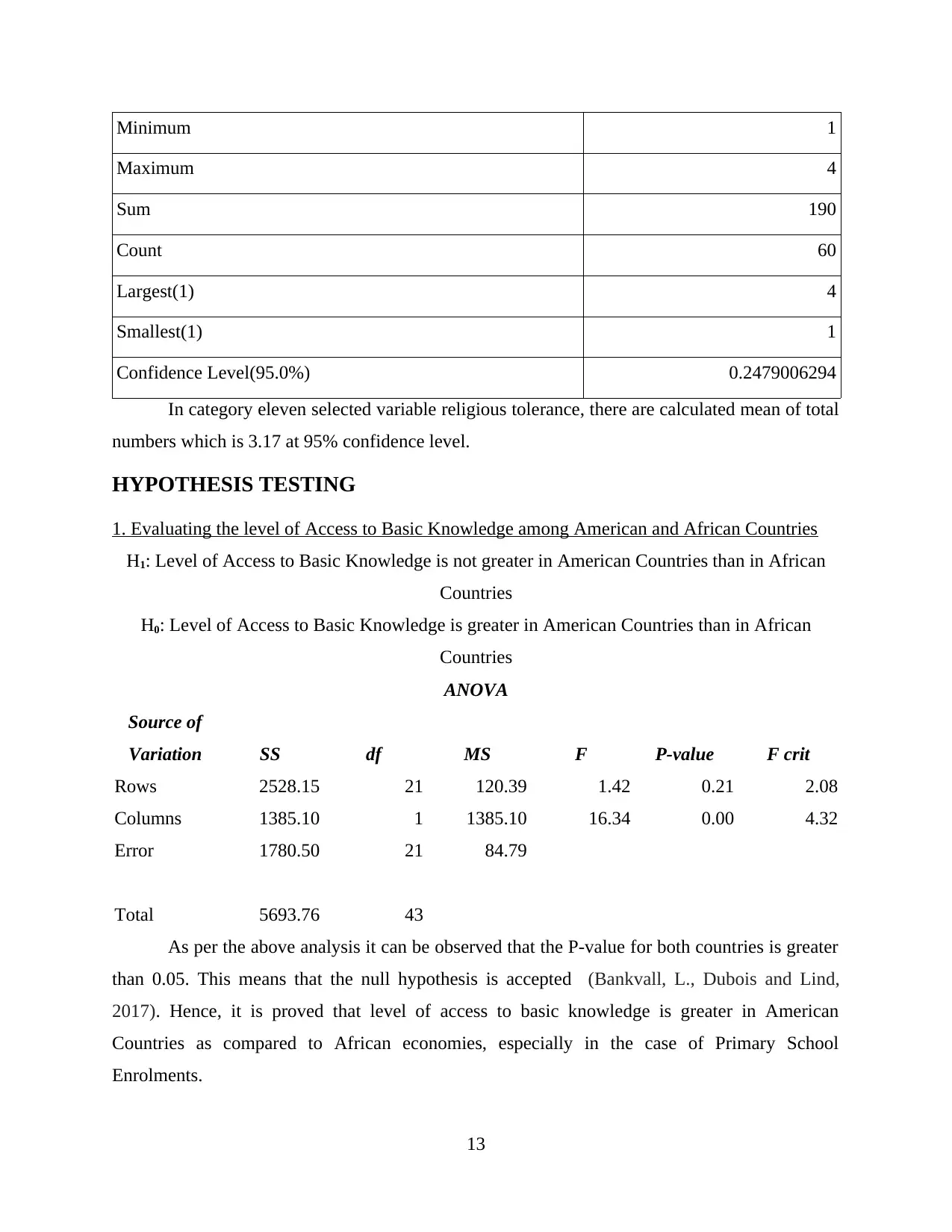
Minimum 1
Maximum 4
Sum 190
Count 60
Largest(1) 4
Smallest(1) 1
Confidence Level(95.0%) 0.2479006294
In category eleven selected variable religious tolerance, there are calculated mean of total
numbers which is 3.17 at 95% confidence level.
HYPOTHESIS TESTING
1. Evaluating the level of Access to Basic Knowledge among American and African Countries
H1: Level of Access to Basic Knowledge is not greater in American Countries than in African
Countries
H0: Level of Access to Basic Knowledge is greater in American Countries than in African
Countries
ANOVA
Source of
Variation SS df MS F P-value F crit
Rows 2528.15 21 120.39 1.42 0.21 2.08
Columns 1385.10 1 1385.10 16.34 0.00 4.32
Error 1780.50 21 84.79
Total 5693.76 43
As per the above analysis it can be observed that the P-value for both countries is greater
than 0.05. This means that the null hypothesis is accepted (Bankvall, L., Dubois and Lind,
2017). Hence, it is proved that level of access to basic knowledge is greater in American
Countries as compared to African economies, especially in the case of Primary School
Enrolments.
13
Maximum 4
Sum 190
Count 60
Largest(1) 4
Smallest(1) 1
Confidence Level(95.0%) 0.2479006294
In category eleven selected variable religious tolerance, there are calculated mean of total
numbers which is 3.17 at 95% confidence level.
HYPOTHESIS TESTING
1. Evaluating the level of Access to Basic Knowledge among American and African Countries
H1: Level of Access to Basic Knowledge is not greater in American Countries than in African
Countries
H0: Level of Access to Basic Knowledge is greater in American Countries than in African
Countries
ANOVA
Source of
Variation SS df MS F P-value F crit
Rows 2528.15 21 120.39 1.42 0.21 2.08
Columns 1385.10 1 1385.10 16.34 0.00 4.32
Error 1780.50 21 84.79
Total 5693.76 43
As per the above analysis it can be observed that the P-value for both countries is greater
than 0.05. This means that the null hypothesis is accepted (Bankvall, L., Dubois and Lind,
2017). Hence, it is proved that level of access to basic knowledge is greater in American
Countries as compared to African economies, especially in the case of Primary School
Enrolments.
13
Paraphrase This Document
Need a fresh take? Get an instant paraphrase of this document with our AI Paraphraser
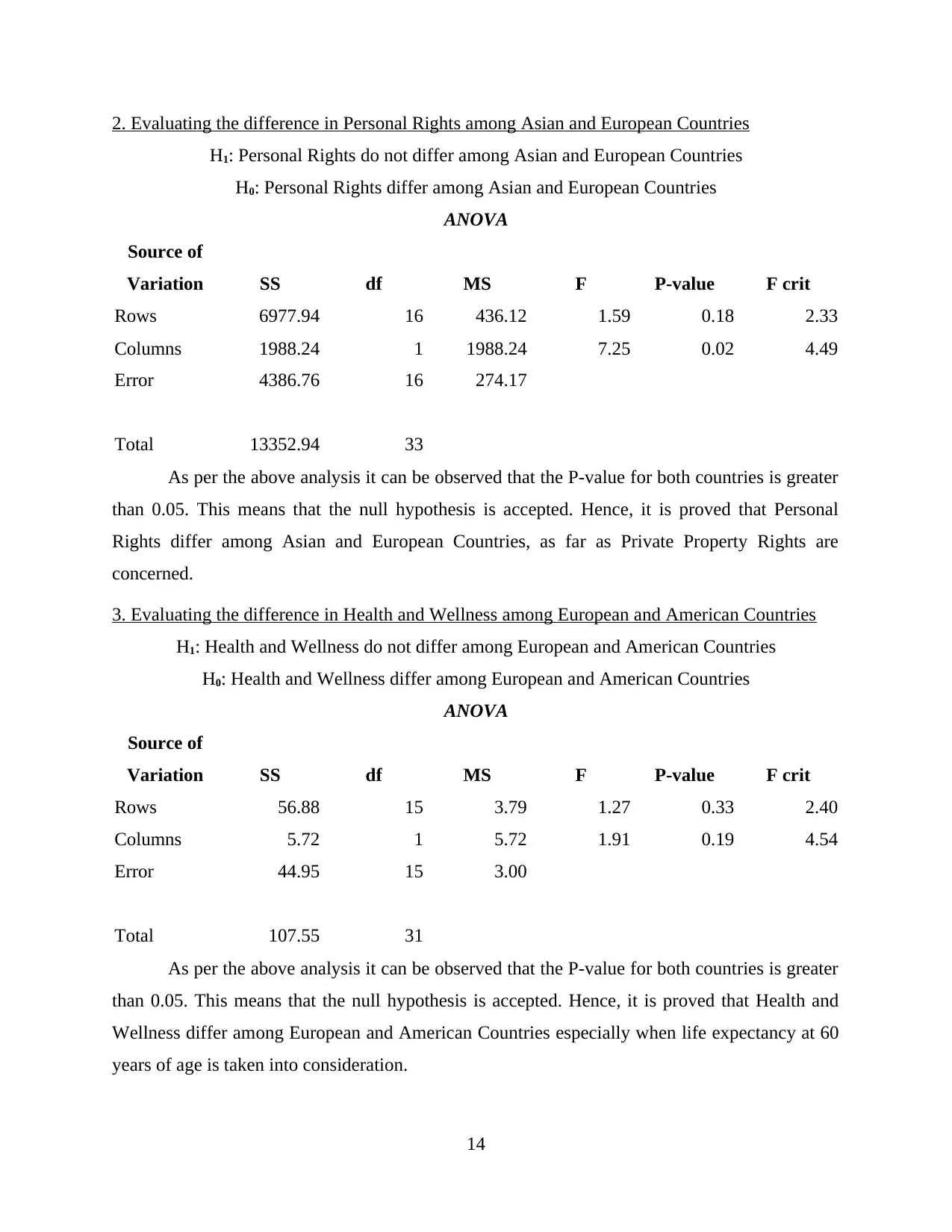
2. Evaluating the difference in Personal Rights among Asian and European Countries
H1: Personal Rights do not differ among Asian and European Countries
H0: Personal Rights differ among Asian and European Countries
ANOVA
Source of
Variation SS df MS F P-value F crit
Rows 6977.94 16 436.12 1.59 0.18 2.33
Columns 1988.24 1 1988.24 7.25 0.02 4.49
Error 4386.76 16 274.17
Total 13352.94 33
As per the above analysis it can be observed that the P-value for both countries is greater
than 0.05. This means that the null hypothesis is accepted. Hence, it is proved that Personal
Rights differ among Asian and European Countries, as far as Private Property Rights are
concerned.
3. Evaluating the difference in Health and Wellness among European and American Countries
H1: Health and Wellness do not differ among European and American Countries
H0: Health and Wellness differ among European and American Countries
ANOVA
Source of
Variation SS df MS F P-value F crit
Rows 56.88 15 3.79 1.27 0.33 2.40
Columns 5.72 1 5.72 1.91 0.19 4.54
Error 44.95 15 3.00
Total 107.55 31
As per the above analysis it can be observed that the P-value for both countries is greater
than 0.05. This means that the null hypothesis is accepted. Hence, it is proved that Health and
Wellness differ among European and American Countries especially when life expectancy at 60
years of age is taken into consideration.
14
H1: Personal Rights do not differ among Asian and European Countries
H0: Personal Rights differ among Asian and European Countries
ANOVA
Source of
Variation SS df MS F P-value F crit
Rows 6977.94 16 436.12 1.59 0.18 2.33
Columns 1988.24 1 1988.24 7.25 0.02 4.49
Error 4386.76 16 274.17
Total 13352.94 33
As per the above analysis it can be observed that the P-value for both countries is greater
than 0.05. This means that the null hypothesis is accepted. Hence, it is proved that Personal
Rights differ among Asian and European Countries, as far as Private Property Rights are
concerned.
3. Evaluating the difference in Health and Wellness among European and American Countries
H1: Health and Wellness do not differ among European and American Countries
H0: Health and Wellness differ among European and American Countries
ANOVA
Source of
Variation SS df MS F P-value F crit
Rows 56.88 15 3.79 1.27 0.33 2.40
Columns 5.72 1 5.72 1.91 0.19 4.54
Error 44.95 15 3.00
Total 107.55 31
As per the above analysis it can be observed that the P-value for both countries is greater
than 0.05. This means that the null hypothesis is accepted. Hence, it is proved that Health and
Wellness differ among European and American Countries especially when life expectancy at 60
years of age is taken into consideration.
14
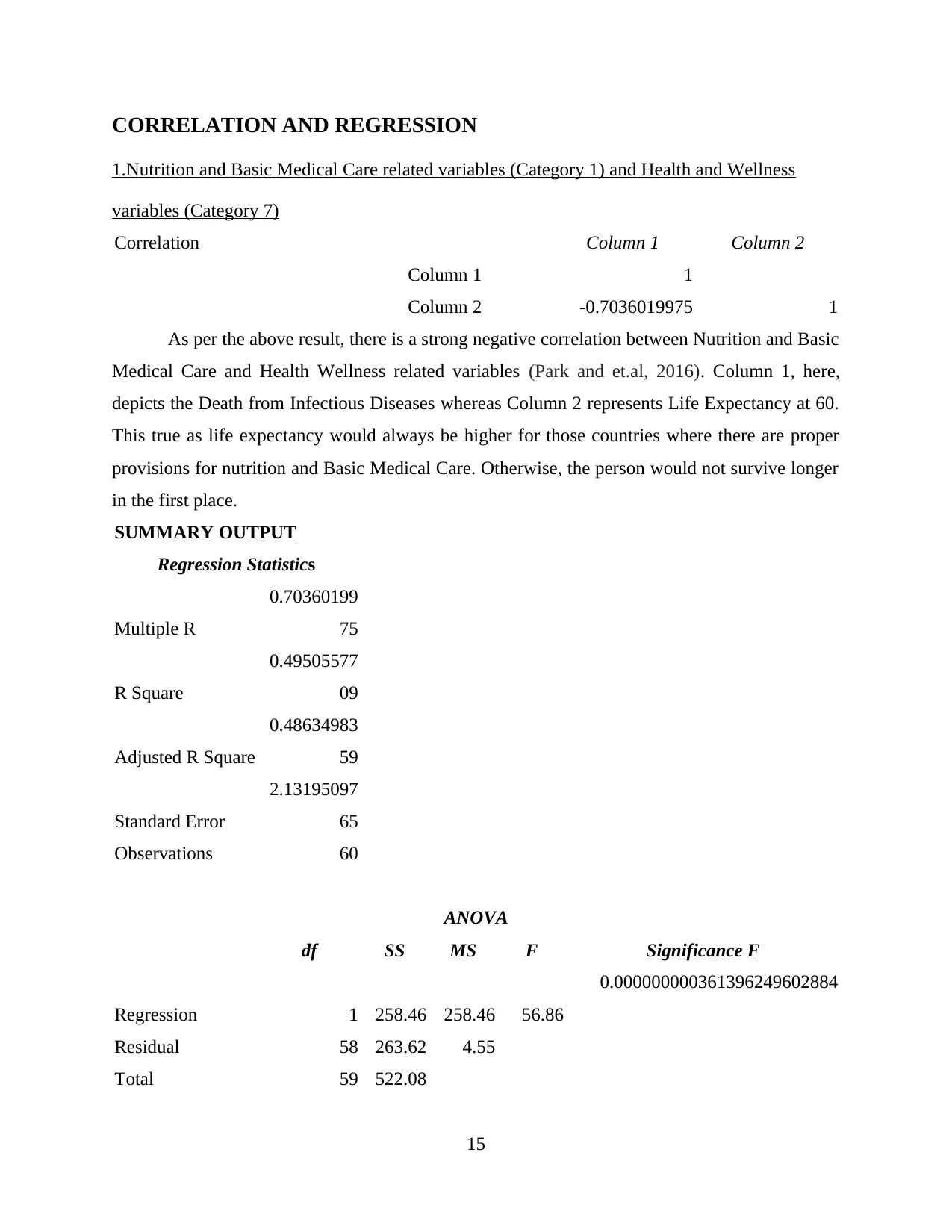
CORRELATION AND REGRESSION
1.Nutrition and Basic Medical Care related variables (Category 1) and Health and Wellness
variables (Category 7)
Correlation Column 1 Column 2
Column 1 1
Column 2 -0.7036019975 1
As per the above result, there is a strong negative correlation between Nutrition and Basic
Medical Care and Health Wellness related variables (Park and et.al, 2016). Column 1, here,
depicts the Death from Infectious Diseases whereas Column 2 represents Life Expectancy at 60.
This true as life expectancy would always be higher for those countries where there are proper
provisions for nutrition and Basic Medical Care. Otherwise, the person would not survive longer
in the first place.
SUMMARY OUTPUT
Regression Statistics
Multiple R
0.70360199
75
R Square
0.49505577
09
Adjusted R Square
0.48634983
59
Standard Error
2.13195097
65
Observations 60
ANOVA
df SS MS F Significance F
Regression 1 258.46 258.46 56.86
0.000000000361396249602884
Residual 58 263.62 4.55
Total 59 522.08
15
1.Nutrition and Basic Medical Care related variables (Category 1) and Health and Wellness
variables (Category 7)
Correlation Column 1 Column 2
Column 1 1
Column 2 -0.7036019975 1
As per the above result, there is a strong negative correlation between Nutrition and Basic
Medical Care and Health Wellness related variables (Park and et.al, 2016). Column 1, here,
depicts the Death from Infectious Diseases whereas Column 2 represents Life Expectancy at 60.
This true as life expectancy would always be higher for those countries where there are proper
provisions for nutrition and Basic Medical Care. Otherwise, the person would not survive longer
in the first place.
SUMMARY OUTPUT
Regression Statistics
Multiple R
0.70360199
75
R Square
0.49505577
09
Adjusted R Square
0.48634983
59
Standard Error
2.13195097
65
Observations 60
ANOVA
df SS MS F Significance F
Regression 1 258.46 258.46 56.86
0.000000000361396249602884
Residual 58 263.62 4.55
Total 59 522.08
15
You're viewing a preview
Unlock full access by subscribing today!
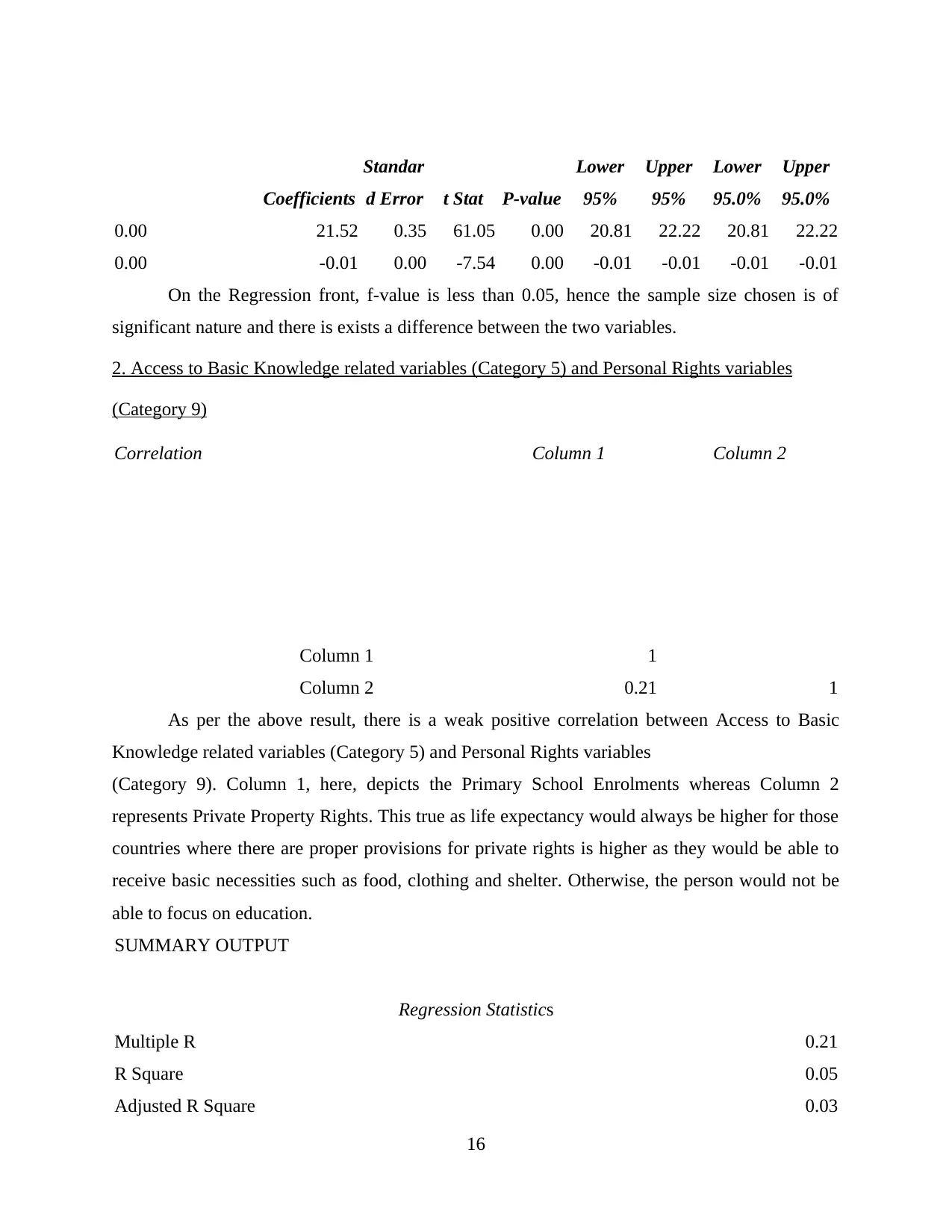
Coefficients
Standar
d Error t Stat P-value
Lower
95%
Upper
95%
Lower
95.0%
Upper
95.0%
0.00 21.52 0.35 61.05 0.00 20.81 22.22 20.81 22.22
0.00 -0.01 0.00 -7.54 0.00 -0.01 -0.01 -0.01 -0.01
On the Regression front, f-value is less than 0.05, hence the sample size chosen is of
significant nature and there is exists a difference between the two variables.
2. Access to Basic Knowledge related variables (Category 5) and Personal Rights variables
(Category 9)
Correlation Column 1 Column 2
Column 1 1
Column 2 0.21 1
As per the above result, there is a weak positive correlation between Access to Basic
Knowledge related variables (Category 5) and Personal Rights variables
(Category 9). Column 1, here, depicts the Primary School Enrolments whereas Column 2
represents Private Property Rights. This true as life expectancy would always be higher for those
countries where there are proper provisions for private rights is higher as they would be able to
receive basic necessities such as food, clothing and shelter. Otherwise, the person would not be
able to focus on education.
SUMMARY OUTPUT
Regression Statistics
Multiple R 0.21
R Square 0.05
Adjusted R Square 0.03
16
Standar
d Error t Stat P-value
Lower
95%
Upper
95%
Lower
95.0%
Upper
95.0%
0.00 21.52 0.35 61.05 0.00 20.81 22.22 20.81 22.22
0.00 -0.01 0.00 -7.54 0.00 -0.01 -0.01 -0.01 -0.01
On the Regression front, f-value is less than 0.05, hence the sample size chosen is of
significant nature and there is exists a difference between the two variables.
2. Access to Basic Knowledge related variables (Category 5) and Personal Rights variables
(Category 9)
Correlation Column 1 Column 2
Column 1 1
Column 2 0.21 1
As per the above result, there is a weak positive correlation between Access to Basic
Knowledge related variables (Category 5) and Personal Rights variables
(Category 9). Column 1, here, depicts the Primary School Enrolments whereas Column 2
represents Private Property Rights. This true as life expectancy would always be higher for those
countries where there are proper provisions for private rights is higher as they would be able to
receive basic necessities such as food, clothing and shelter. Otherwise, the person would not be
able to focus on education.
SUMMARY OUTPUT
Regression Statistics
Multiple R 0.21
R Square 0.05
Adjusted R Square 0.03
16
Paraphrase This Document
Need a fresh take? Get an instant paraphrase of this document with our AI Paraphraser
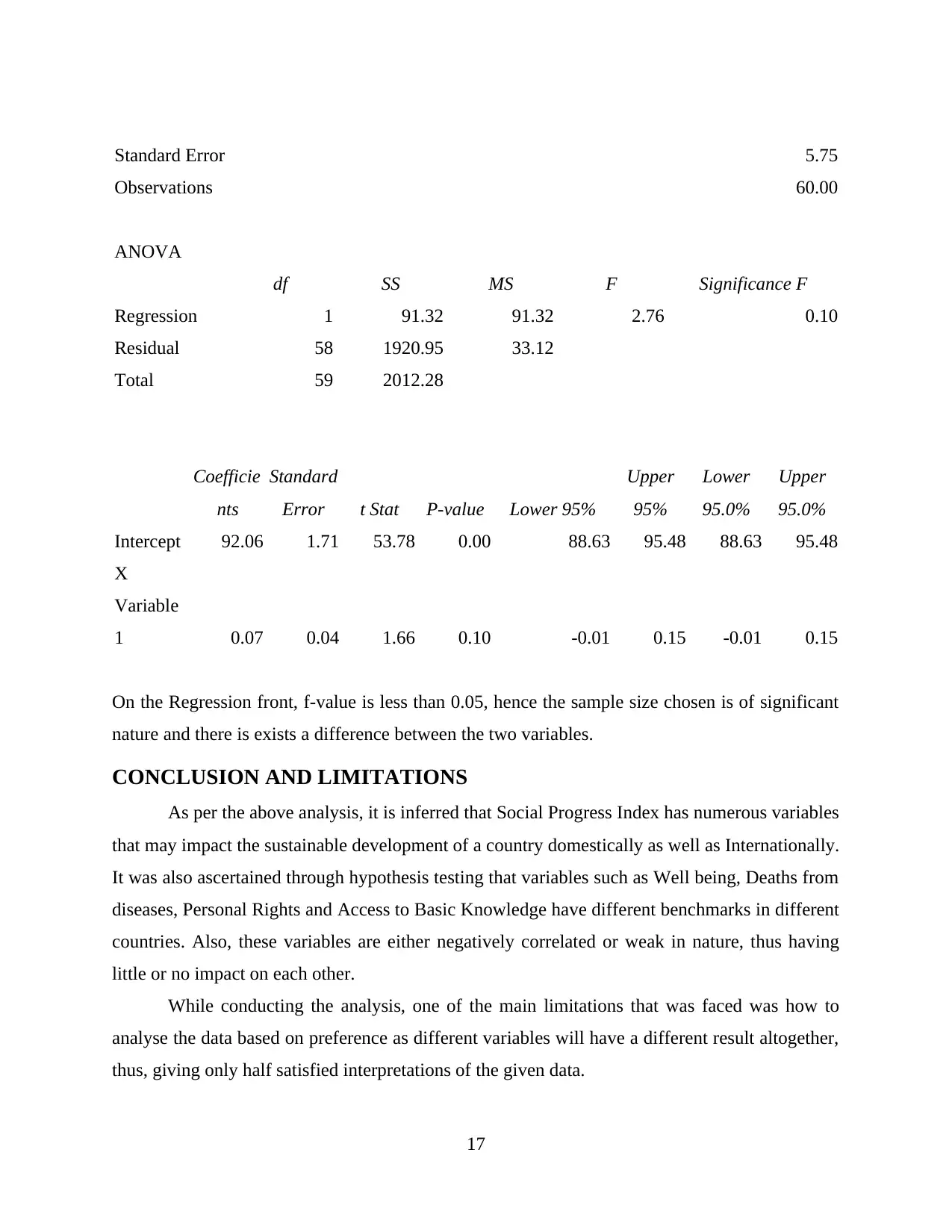
Standard Error 5.75
Observations 60.00
ANOVA
df SS MS F Significance F
Regression 1 91.32 91.32 2.76 0.10
Residual 58 1920.95 33.12
Total 59 2012.28
Coefficie
nts
Standard
Error t Stat P-value Lower 95%
Upper
95%
Lower
95.0%
Upper
95.0%
Intercept 92.06 1.71 53.78 0.00 88.63 95.48 88.63 95.48
X
Variable
1 0.07 0.04 1.66 0.10 -0.01 0.15 -0.01 0.15
On the Regression front, f-value is less than 0.05, hence the sample size chosen is of significant
nature and there is exists a difference between the two variables.
CONCLUSION AND LIMITATIONS
As per the above analysis, it is inferred that Social Progress Index has numerous variables
that may impact the sustainable development of a country domestically as well as Internationally.
It was also ascertained through hypothesis testing that variables such as Well being, Deaths from
diseases, Personal Rights and Access to Basic Knowledge have different benchmarks in different
countries. Also, these variables are either negatively correlated or weak in nature, thus having
little or no impact on each other.
While conducting the analysis, one of the main limitations that was faced was how to
analyse the data based on preference as different variables will have a different result altogether,
thus, giving only half satisfied interpretations of the given data.
17
Observations 60.00
ANOVA
df SS MS F Significance F
Regression 1 91.32 91.32 2.76 0.10
Residual 58 1920.95 33.12
Total 59 2012.28
Coefficie
nts
Standard
Error t Stat P-value Lower 95%
Upper
95%
Lower
95.0%
Upper
95.0%
Intercept 92.06 1.71 53.78 0.00 88.63 95.48 88.63 95.48
X
Variable
1 0.07 0.04 1.66 0.10 -0.01 0.15 -0.01 0.15
On the Regression front, f-value is less than 0.05, hence the sample size chosen is of significant
nature and there is exists a difference between the two variables.
CONCLUSION AND LIMITATIONS
As per the above analysis, it is inferred that Social Progress Index has numerous variables
that may impact the sustainable development of a country domestically as well as Internationally.
It was also ascertained through hypothesis testing that variables such as Well being, Deaths from
diseases, Personal Rights and Access to Basic Knowledge have different benchmarks in different
countries. Also, these variables are either negatively correlated or weak in nature, thus having
little or no impact on each other.
While conducting the analysis, one of the main limitations that was faced was how to
analyse the data based on preference as different variables will have a different result altogether,
thus, giving only half satisfied interpretations of the given data.
17
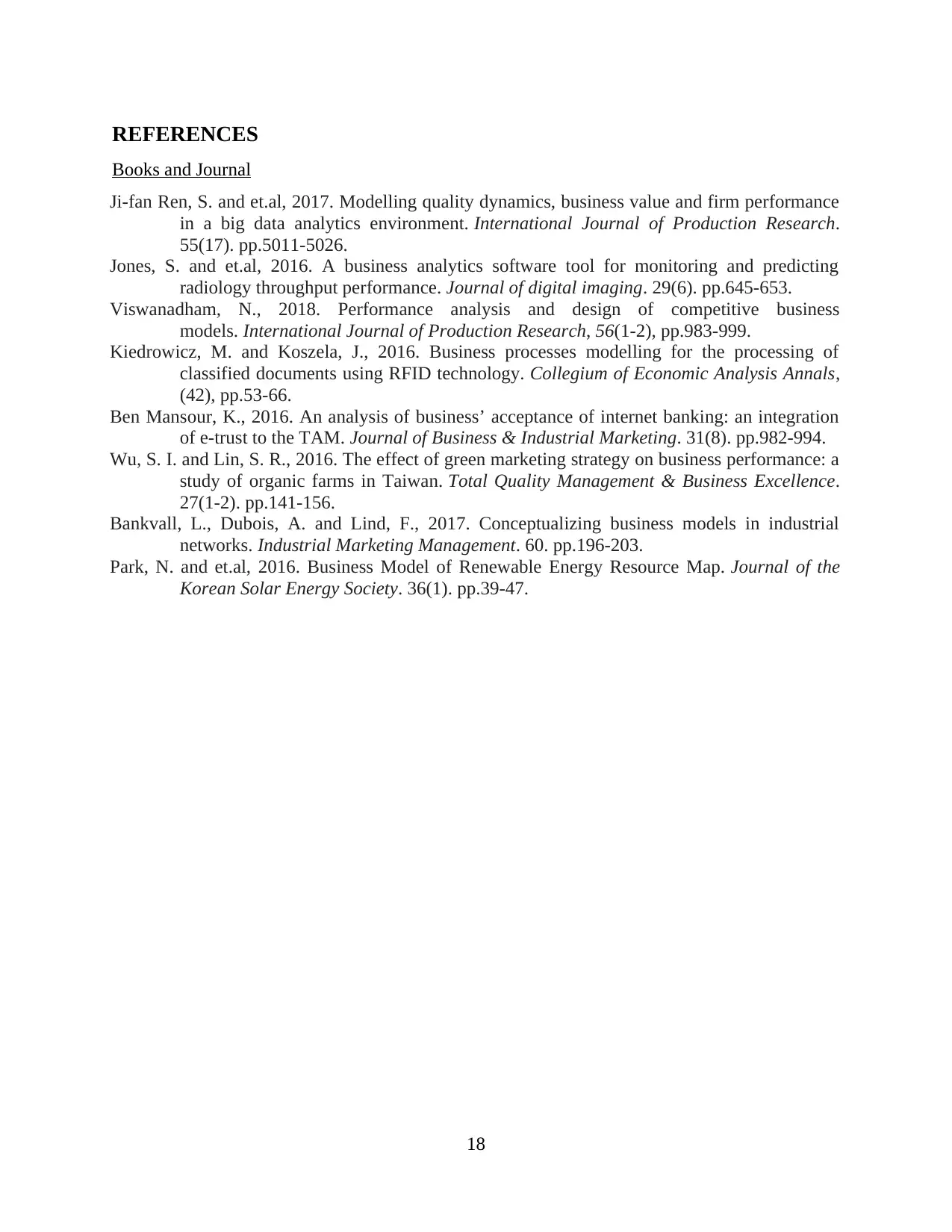
REFERENCES
Books and Journal
Ji-fan Ren, S. and et.al, 2017. Modelling quality dynamics, business value and firm performance
in a big data analytics environment. International Journal of Production Research.
55(17). pp.5011-5026.
Jones, S. and et.al, 2016. A business analytics software tool for monitoring and predicting
radiology throughput performance. Journal of digital imaging. 29(6). pp.645-653.
Viswanadham, N., 2018. Performance analysis and design of competitive business
models. International Journal of Production Research, 56(1-2), pp.983-999.
Kiedrowicz, M. and Koszela, J., 2016. Business processes modelling for the processing of
classified documents using RFID technology. Collegium of Economic Analysis Annals,
(42), pp.53-66.
Ben Mansour, K., 2016. An analysis of business’ acceptance of internet banking: an integration
of e-trust to the TAM. Journal of Business & Industrial Marketing. 31(8). pp.982-994.
Wu, S. I. and Lin, S. R., 2016. The effect of green marketing strategy on business performance: a
study of organic farms in Taiwan. Total Quality Management & Business Excellence.
27(1-2). pp.141-156.
Bankvall, L., Dubois, A. and Lind, F., 2017. Conceptualizing business models in industrial
networks. Industrial Marketing Management. 60. pp.196-203.
Park, N. and et.al, 2016. Business Model of Renewable Energy Resource Map. Journal of the
Korean Solar Energy Society. 36(1). pp.39-47.
18
Books and Journal
Ji-fan Ren, S. and et.al, 2017. Modelling quality dynamics, business value and firm performance
in a big data analytics environment. International Journal of Production Research.
55(17). pp.5011-5026.
Jones, S. and et.al, 2016. A business analytics software tool for monitoring and predicting
radiology throughput performance. Journal of digital imaging. 29(6). pp.645-653.
Viswanadham, N., 2018. Performance analysis and design of competitive business
models. International Journal of Production Research, 56(1-2), pp.983-999.
Kiedrowicz, M. and Koszela, J., 2016. Business processes modelling for the processing of
classified documents using RFID technology. Collegium of Economic Analysis Annals,
(42), pp.53-66.
Ben Mansour, K., 2016. An analysis of business’ acceptance of internet banking: an integration
of e-trust to the TAM. Journal of Business & Industrial Marketing. 31(8). pp.982-994.
Wu, S. I. and Lin, S. R., 2016. The effect of green marketing strategy on business performance: a
study of organic farms in Taiwan. Total Quality Management & Business Excellence.
27(1-2). pp.141-156.
Bankvall, L., Dubois, A. and Lind, F., 2017. Conceptualizing business models in industrial
networks. Industrial Marketing Management. 60. pp.196-203.
Park, N. and et.al, 2016. Business Model of Renewable Energy Resource Map. Journal of the
Korean Solar Energy Society. 36(1). pp.39-47.
18
You're viewing a preview
Unlock full access by subscribing today!
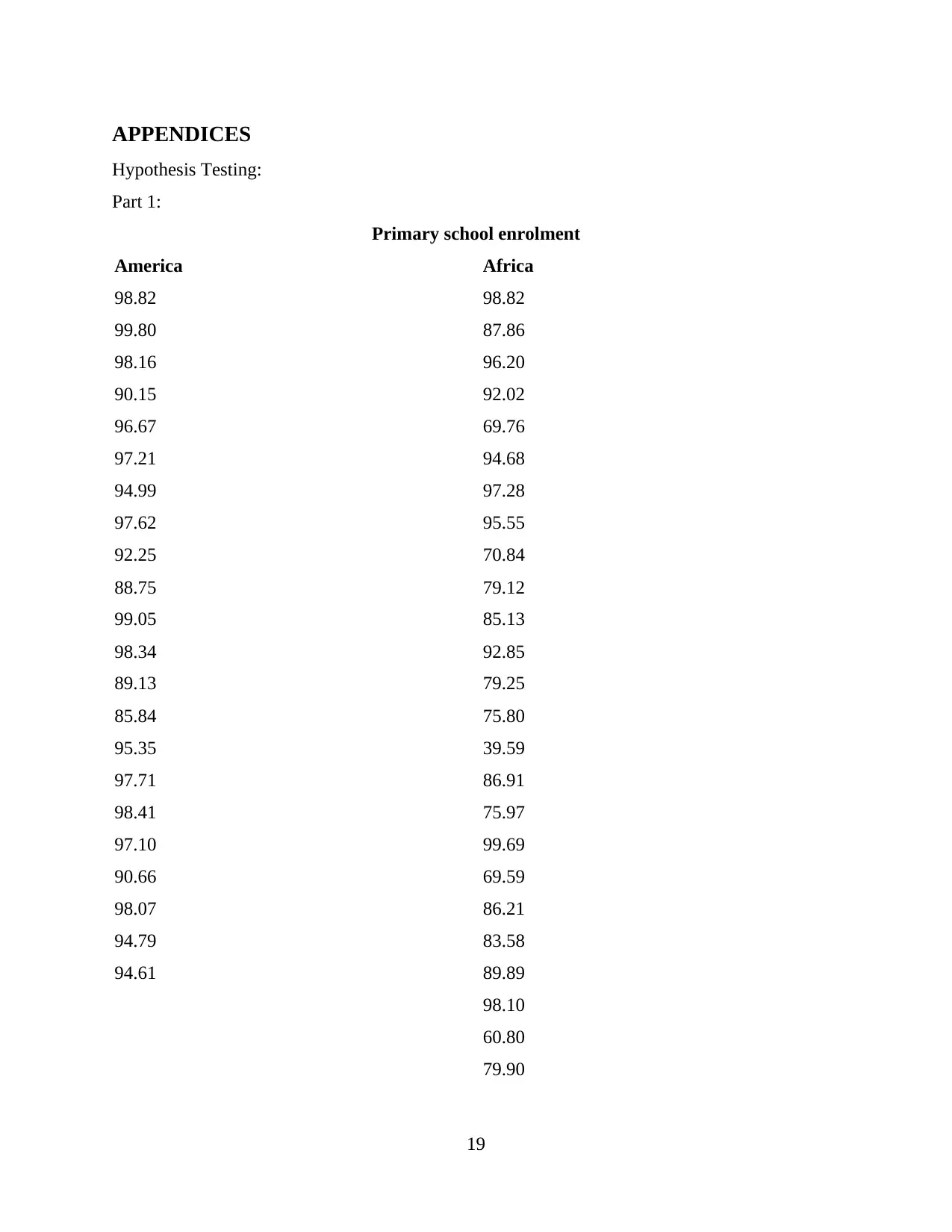
APPENDICES
Hypothesis Testing:
Part 1:
Primary school enrolment
America Africa
98.82 98.82
99.80 87.86
98.16 96.20
90.15 92.02
96.67 69.76
97.21 94.68
94.99 97.28
97.62 95.55
92.25 70.84
88.75 79.12
99.05 85.13
98.34 92.85
89.13 79.25
85.84 75.80
95.35 39.59
97.71 86.91
98.41 75.97
97.10 99.69
90.66 69.59
98.07 86.21
94.79 83.58
94.61 89.89
98.10
60.80
79.90
19
Hypothesis Testing:
Part 1:
Primary school enrolment
America Africa
98.82 98.82
99.80 87.86
98.16 96.20
90.15 92.02
96.67 69.76
97.21 94.68
94.99 97.28
97.62 95.55
92.25 70.84
88.75 79.12
99.05 85.13
98.34 92.85
89.13 79.25
85.84 75.80
95.35 39.59
97.71 86.91
98.41 75.97
97.10 99.69
90.66 69.59
98.07 86.21
94.79 83.58
94.61 89.89
98.10
60.80
79.90
19
Paraphrase This Document
Need a fresh take? Get an instant paraphrase of this document with our AI Paraphraser
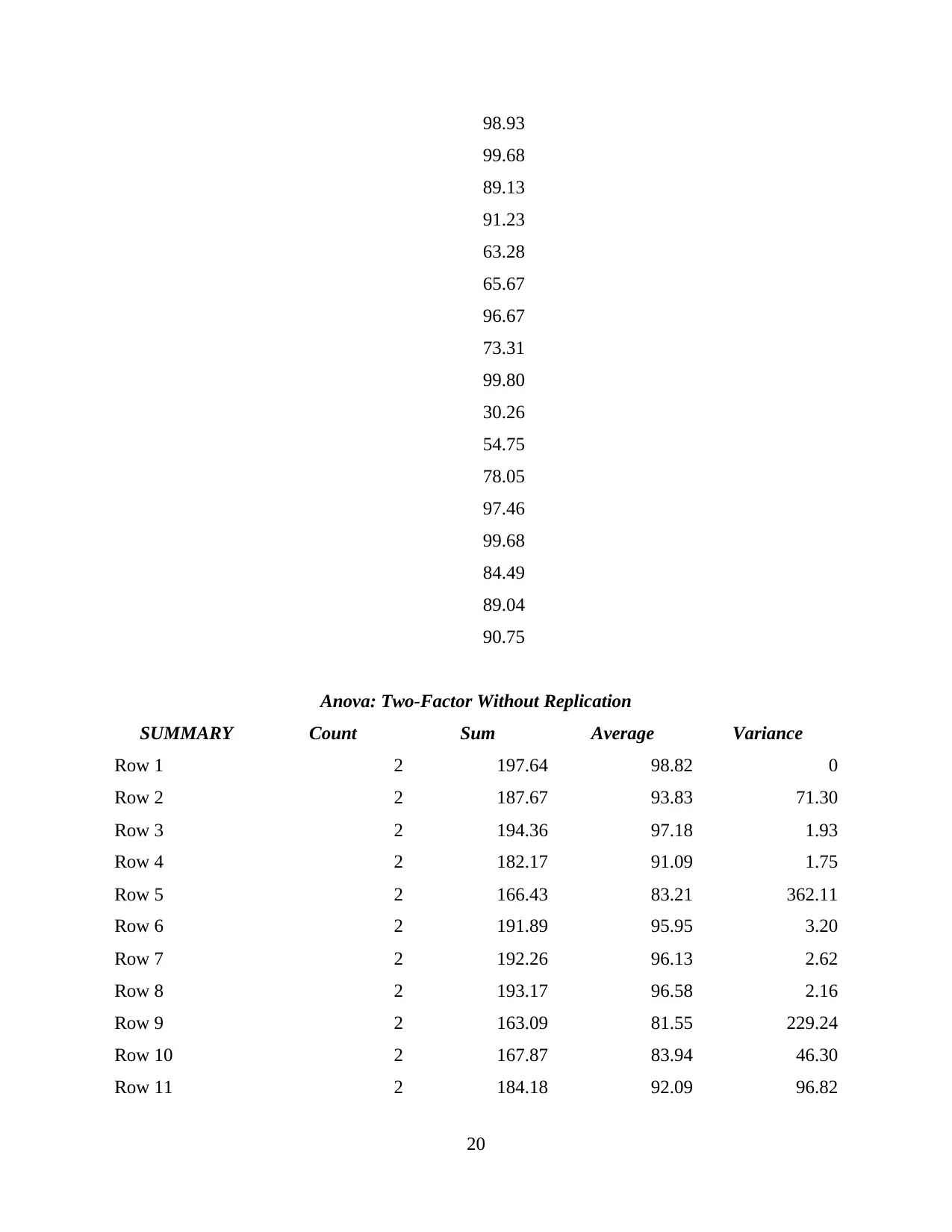
98.93
99.68
89.13
91.23
63.28
65.67
96.67
73.31
99.80
30.26
54.75
78.05
97.46
99.68
84.49
89.04
90.75
Anova: Two-Factor Without Replication
SUMMARY Count Sum Average Variance
Row 1 2 197.64 98.82 0
Row 2 2 187.67 93.83 71.30
Row 3 2 194.36 97.18 1.93
Row 4 2 182.17 91.09 1.75
Row 5 2 166.43 83.21 362.11
Row 6 2 191.89 95.95 3.20
Row 7 2 192.26 96.13 2.62
Row 8 2 193.17 96.58 2.16
Row 9 2 163.09 81.55 229.24
Row 10 2 167.87 83.94 46.30
Row 11 2 184.18 92.09 96.82
20
99.68
89.13
91.23
63.28
65.67
96.67
73.31
99.80
30.26
54.75
78.05
97.46
99.68
84.49
89.04
90.75
Anova: Two-Factor Without Replication
SUMMARY Count Sum Average Variance
Row 1 2 197.64 98.82 0
Row 2 2 187.67 93.83 71.30
Row 3 2 194.36 97.18 1.93
Row 4 2 182.17 91.09 1.75
Row 5 2 166.43 83.21 362.11
Row 6 2 191.89 95.95 3.20
Row 7 2 192.26 96.13 2.62
Row 8 2 193.17 96.58 2.16
Row 9 2 163.09 81.55 229.24
Row 10 2 167.87 83.94 46.30
Row 11 2 184.18 92.09 96.82
20
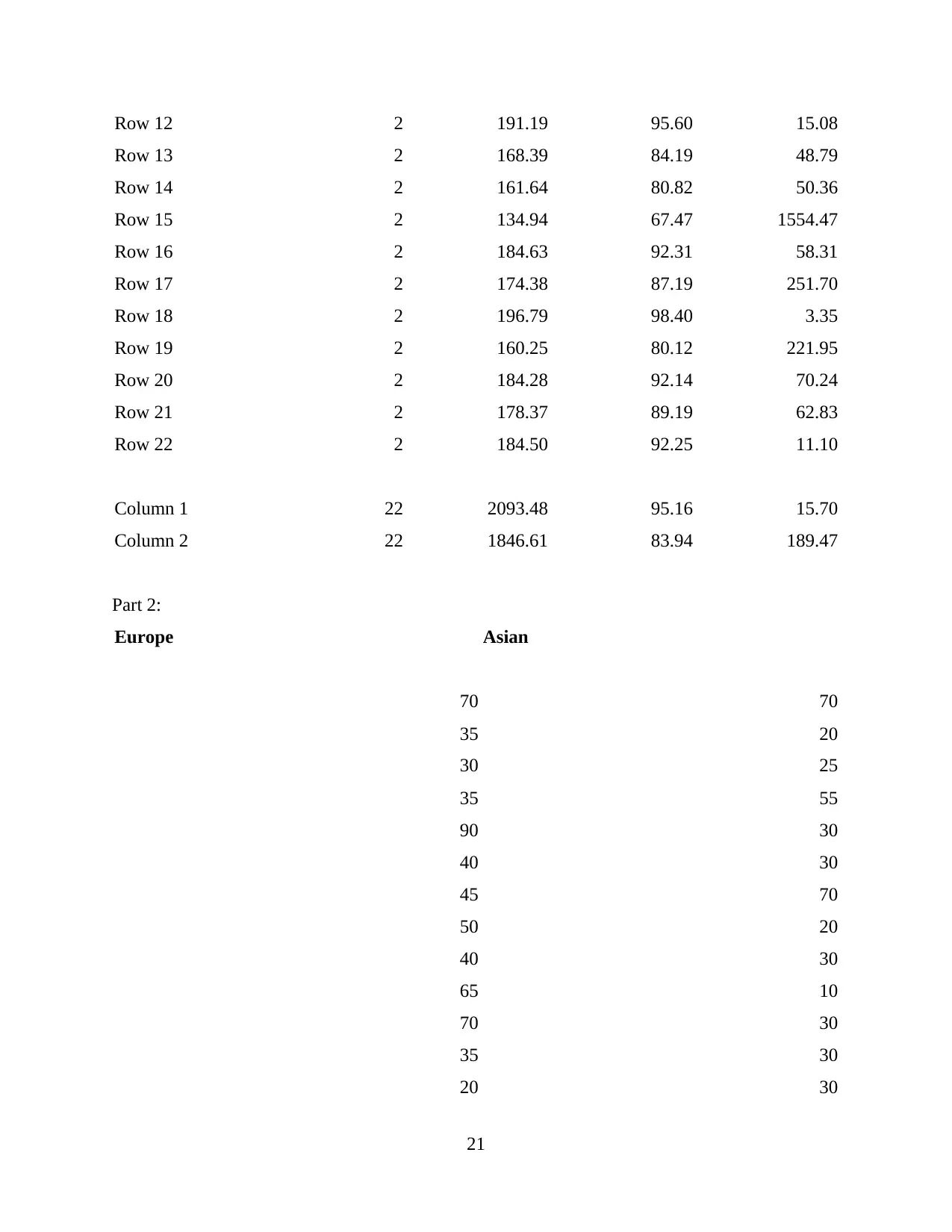
Row 12 2 191.19 95.60 15.08
Row 13 2 168.39 84.19 48.79
Row 14 2 161.64 80.82 50.36
Row 15 2 134.94 67.47 1554.47
Row 16 2 184.63 92.31 58.31
Row 17 2 174.38 87.19 251.70
Row 18 2 196.79 98.40 3.35
Row 19 2 160.25 80.12 221.95
Row 20 2 184.28 92.14 70.24
Row 21 2 178.37 89.19 62.83
Row 22 2 184.50 92.25 11.10
Column 1 22 2093.48 95.16 15.70
Column 2 22 1846.61 83.94 189.47
Part 2:
Europe Asian
70 70
35 20
30 25
35 55
90 30
40 30
45 70
50 20
40 30
65 10
70 30
35 30
20 30
21
Row 13 2 168.39 84.19 48.79
Row 14 2 161.64 80.82 50.36
Row 15 2 134.94 67.47 1554.47
Row 16 2 184.63 92.31 58.31
Row 17 2 174.38 87.19 251.70
Row 18 2 196.79 98.40 3.35
Row 19 2 160.25 80.12 221.95
Row 20 2 184.28 92.14 70.24
Row 21 2 178.37 89.19 62.83
Row 22 2 184.50 92.25 11.10
Column 1 22 2093.48 95.16 15.70
Column 2 22 1846.61 83.94 189.47
Part 2:
Europe Asian
70 70
35 20
30 25
35 55
90 30
40 30
45 70
50 20
40 30
65 10
70 30
35 30
20 30
21
You're viewing a preview
Unlock full access by subscribing today!
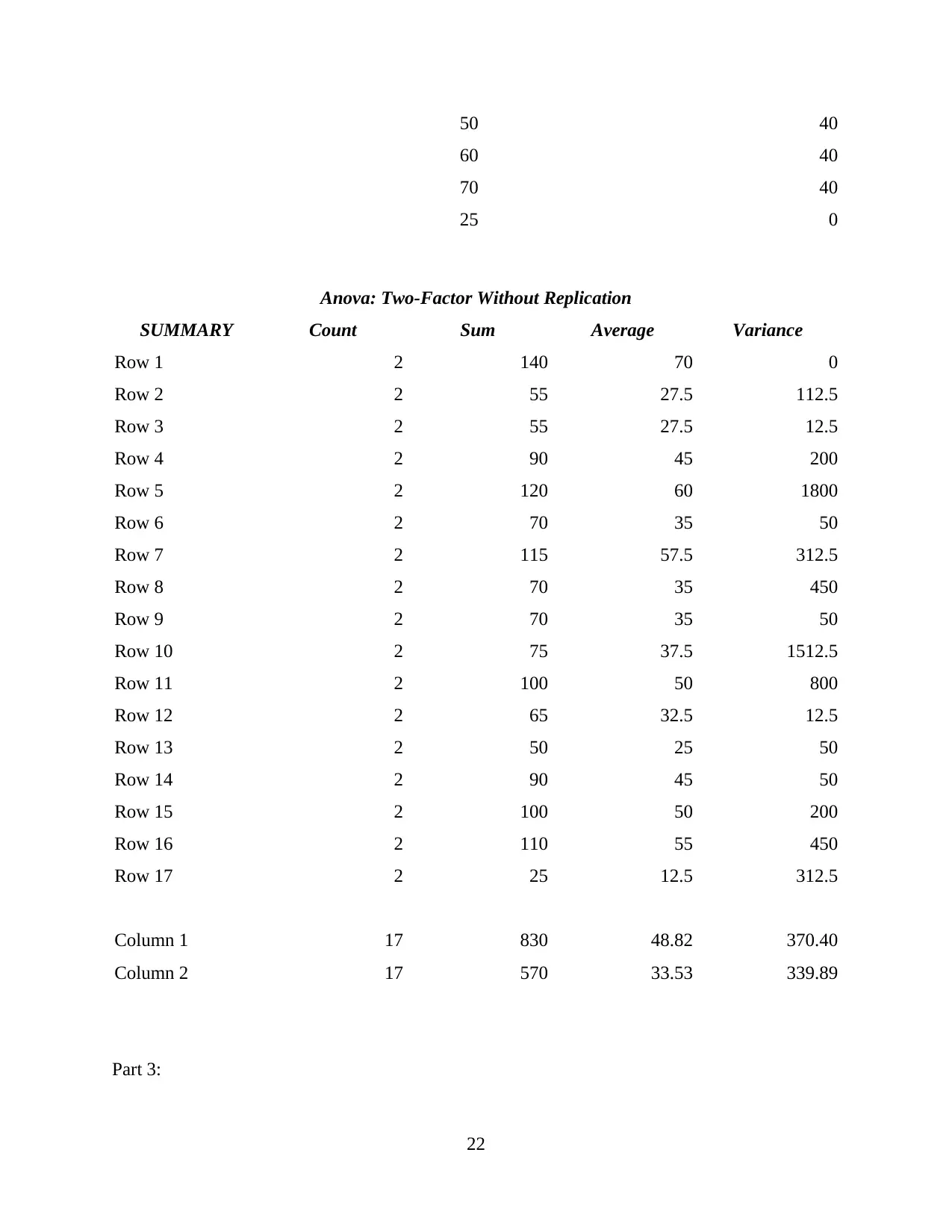
50 40
60 40
70 40
25 0
Anova: Two-Factor Without Replication
SUMMARY Count Sum Average Variance
Row 1 2 140 70 0
Row 2 2 55 27.5 112.5
Row 3 2 55 27.5 12.5
Row 4 2 90 45 200
Row 5 2 120 60 1800
Row 6 2 70 35 50
Row 7 2 115 57.5 312.5
Row 8 2 70 35 450
Row 9 2 70 35 50
Row 10 2 75 37.5 1512.5
Row 11 2 100 50 800
Row 12 2 65 32.5 12.5
Row 13 2 50 25 50
Row 14 2 90 45 50
Row 15 2 100 50 200
Row 16 2 110 55 450
Row 17 2 25 12.5 312.5
Column 1 17 830 48.82 370.40
Column 2 17 570 33.53 339.89
Part 3:
22
60 40
70 40
25 0
Anova: Two-Factor Without Replication
SUMMARY Count Sum Average Variance
Row 1 2 140 70 0
Row 2 2 55 27.5 112.5
Row 3 2 55 27.5 12.5
Row 4 2 90 45 200
Row 5 2 120 60 1800
Row 6 2 70 35 50
Row 7 2 115 57.5 312.5
Row 8 2 70 35 450
Row 9 2 70 35 50
Row 10 2 75 37.5 1512.5
Row 11 2 100 50 800
Row 12 2 65 32.5 12.5
Row 13 2 50 25 50
Row 14 2 90 45 50
Row 15 2 100 50 200
Row 16 2 110 55 450
Row 17 2 25 12.5 312.5
Column 1 17 830 48.82 370.40
Column 2 17 570 33.53 339.89
Part 3:
22
Paraphrase This Document
Need a fresh take? Get an instant paraphrase of this document with our AI Paraphraser
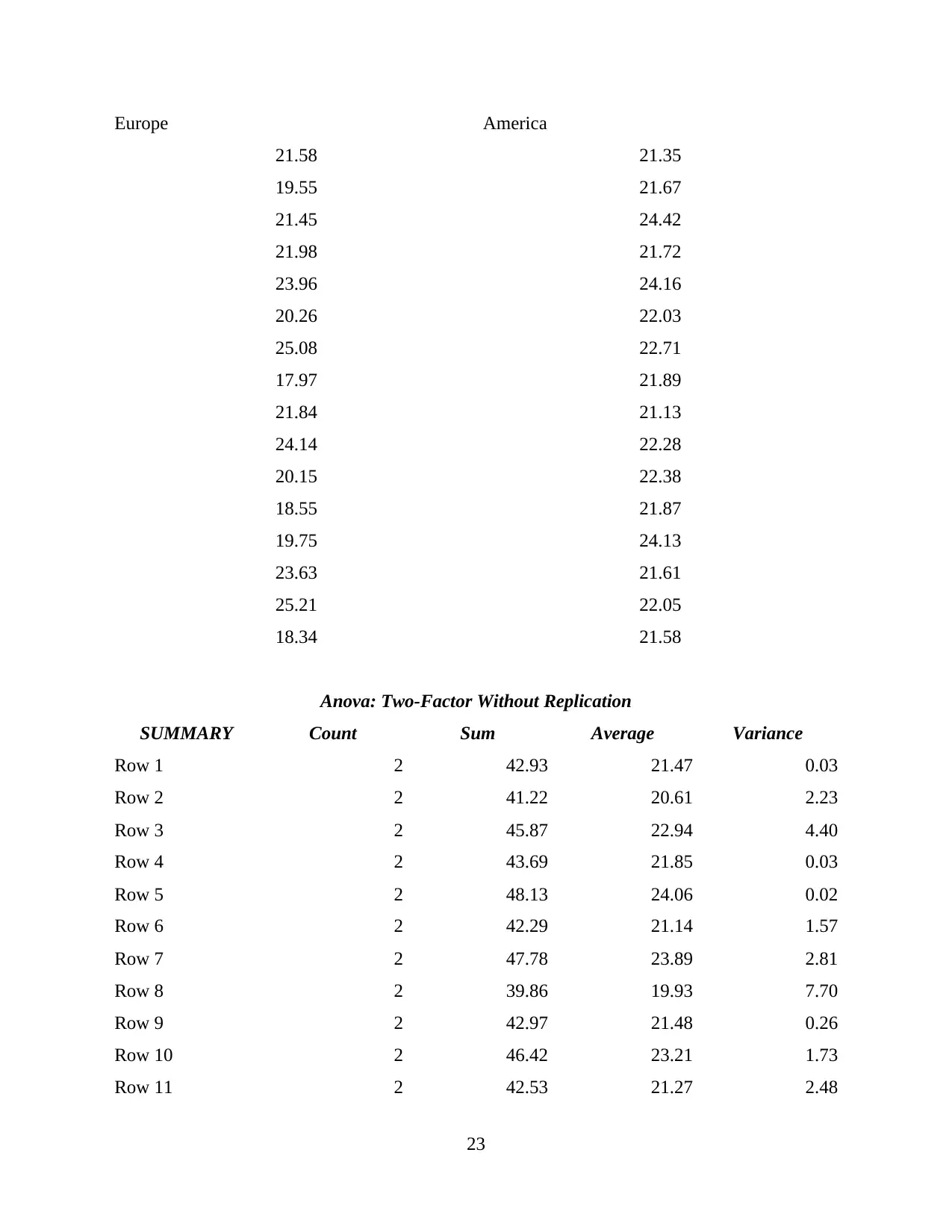
Europe America
21.58 21.35
19.55 21.67
21.45 24.42
21.98 21.72
23.96 24.16
20.26 22.03
25.08 22.71
17.97 21.89
21.84 21.13
24.14 22.28
20.15 22.38
18.55 21.87
19.75 24.13
23.63 21.61
25.21 22.05
18.34 21.58
Anova: Two-Factor Without Replication
SUMMARY Count Sum Average Variance
Row 1 2 42.93 21.47 0.03
Row 2 2 41.22 20.61 2.23
Row 3 2 45.87 22.94 4.40
Row 4 2 43.69 21.85 0.03
Row 5 2 48.13 24.06 0.02
Row 6 2 42.29 21.14 1.57
Row 7 2 47.78 23.89 2.81
Row 8 2 39.86 19.93 7.70
Row 9 2 42.97 21.48 0.26
Row 10 2 46.42 23.21 1.73
Row 11 2 42.53 21.27 2.48
23
21.58 21.35
19.55 21.67
21.45 24.42
21.98 21.72
23.96 24.16
20.26 22.03
25.08 22.71
17.97 21.89
21.84 21.13
24.14 22.28
20.15 22.38
18.55 21.87
19.75 24.13
23.63 21.61
25.21 22.05
18.34 21.58
Anova: Two-Factor Without Replication
SUMMARY Count Sum Average Variance
Row 1 2 42.93 21.47 0.03
Row 2 2 41.22 20.61 2.23
Row 3 2 45.87 22.94 4.40
Row 4 2 43.69 21.85 0.03
Row 5 2 48.13 24.06 0.02
Row 6 2 42.29 21.14 1.57
Row 7 2 47.78 23.89 2.81
Row 8 2 39.86 19.93 7.70
Row 9 2 42.97 21.48 0.26
Row 10 2 46.42 23.21 1.73
Row 11 2 42.53 21.27 2.48
23
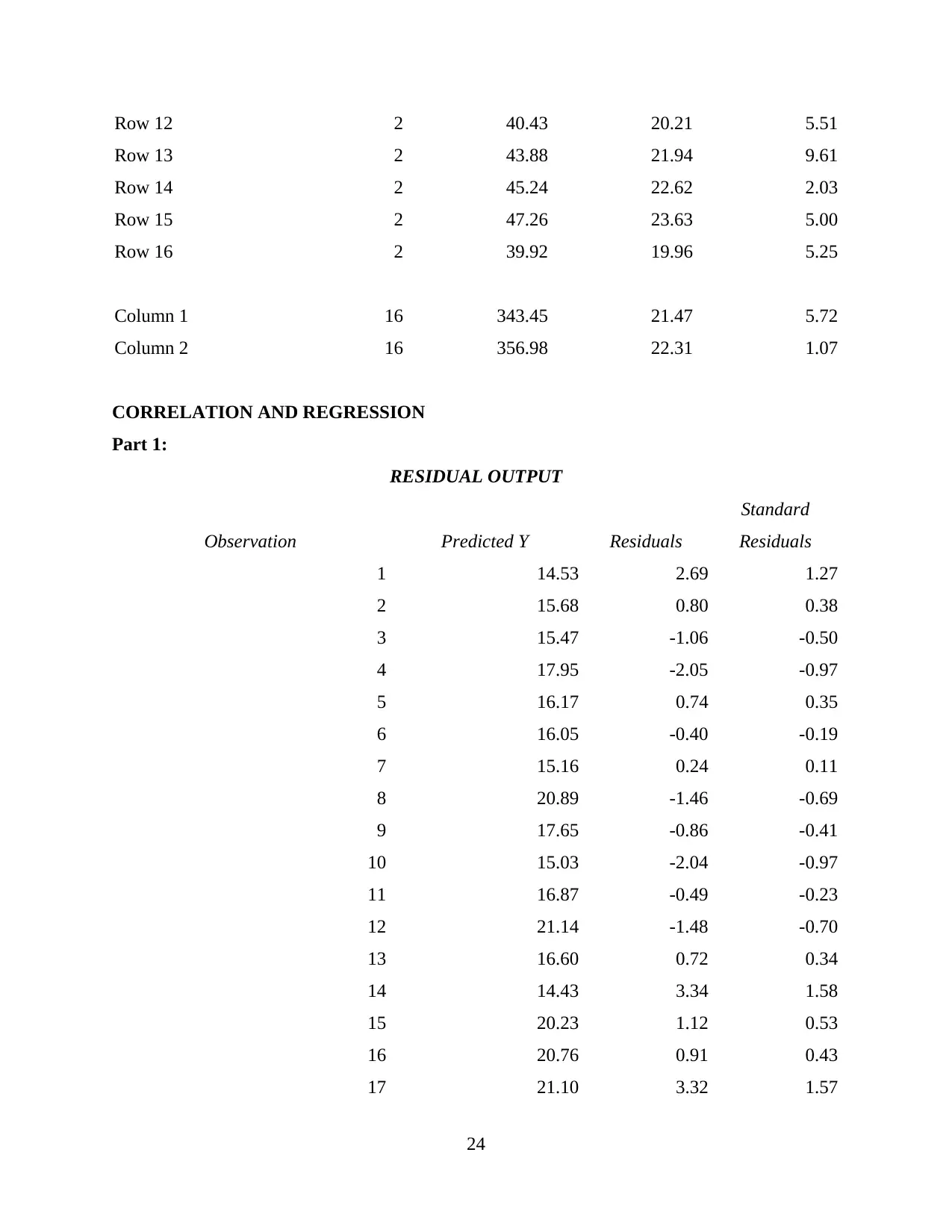
Row 12 2 40.43 20.21 5.51
Row 13 2 43.88 21.94 9.61
Row 14 2 45.24 22.62 2.03
Row 15 2 47.26 23.63 5.00
Row 16 2 39.92 19.96 5.25
Column 1 16 343.45 21.47 5.72
Column 2 16 356.98 22.31 1.07
CORRELATION AND REGRESSION
Part 1:
RESIDUAL OUTPUT
Observation Predicted Y Residuals
Standard
Residuals
1 14.53 2.69 1.27
2 15.68 0.80 0.38
3 15.47 -1.06 -0.50
4 17.95 -2.05 -0.97
5 16.17 0.74 0.35
6 16.05 -0.40 -0.19
7 15.16 0.24 0.11
8 20.89 -1.46 -0.69
9 17.65 -0.86 -0.41
10 15.03 -2.04 -0.97
11 16.87 -0.49 -0.23
12 21.14 -1.48 -0.70
13 16.60 0.72 0.34
14 14.43 3.34 1.58
15 20.23 1.12 0.53
16 20.76 0.91 0.43
17 21.10 3.32 1.57
24
Row 13 2 43.88 21.94 9.61
Row 14 2 45.24 22.62 2.03
Row 15 2 47.26 23.63 5.00
Row 16 2 39.92 19.96 5.25
Column 1 16 343.45 21.47 5.72
Column 2 16 356.98 22.31 1.07
CORRELATION AND REGRESSION
Part 1:
RESIDUAL OUTPUT
Observation Predicted Y Residuals
Standard
Residuals
1 14.53 2.69 1.27
2 15.68 0.80 0.38
3 15.47 -1.06 -0.50
4 17.95 -2.05 -0.97
5 16.17 0.74 0.35
6 16.05 -0.40 -0.19
7 15.16 0.24 0.11
8 20.89 -1.46 -0.69
9 17.65 -0.86 -0.41
10 15.03 -2.04 -0.97
11 16.87 -0.49 -0.23
12 21.14 -1.48 -0.70
13 16.60 0.72 0.34
14 14.43 3.34 1.58
15 20.23 1.12 0.53
16 20.76 0.91 0.43
17 21.10 3.32 1.57
24
You're viewing a preview
Unlock full access by subscribing today!
1 out of 27
Related Documents
Your All-in-One AI-Powered Toolkit for Academic Success.
+13062052269
info@desklib.com
Available 24*7 on WhatsApp / Email
![[object Object]](/_next/static/media/star-bottom.7253800d.svg)
Unlock your academic potential
© 2024 | Zucol Services PVT LTD | All rights reserved.





